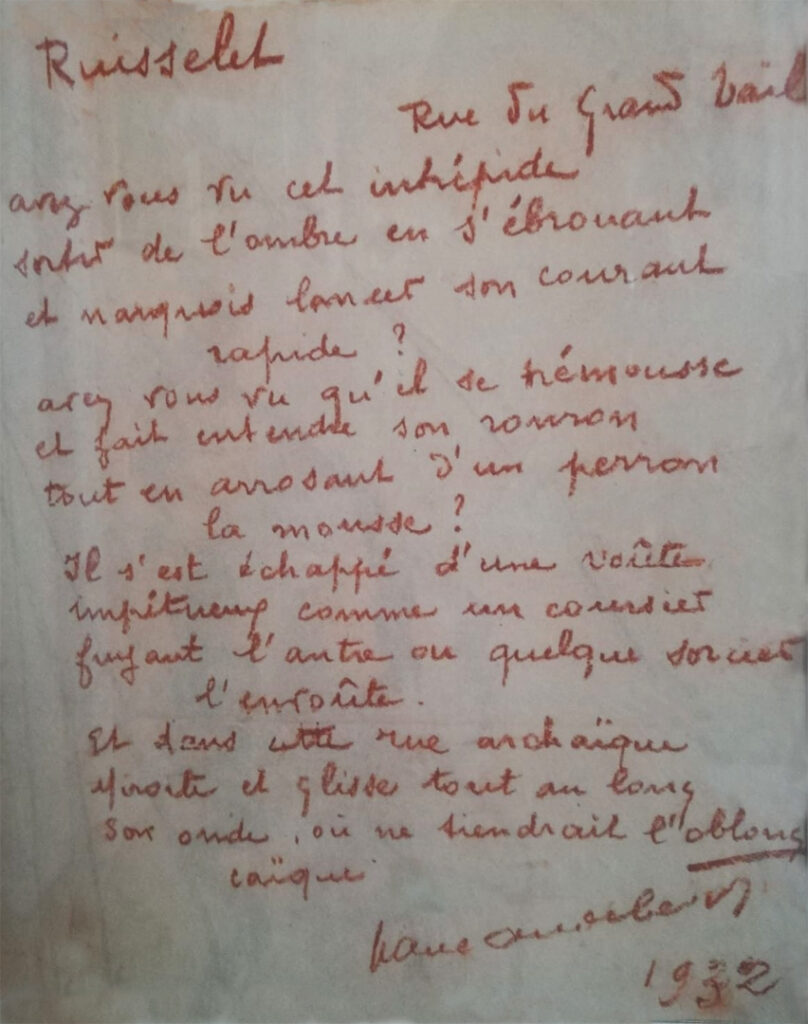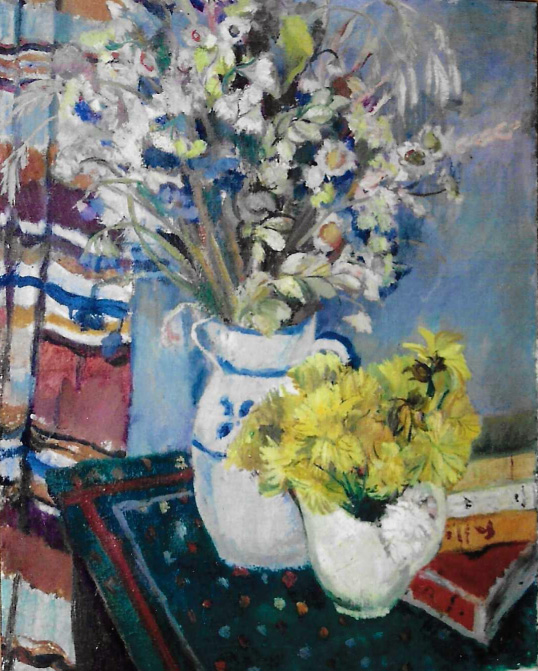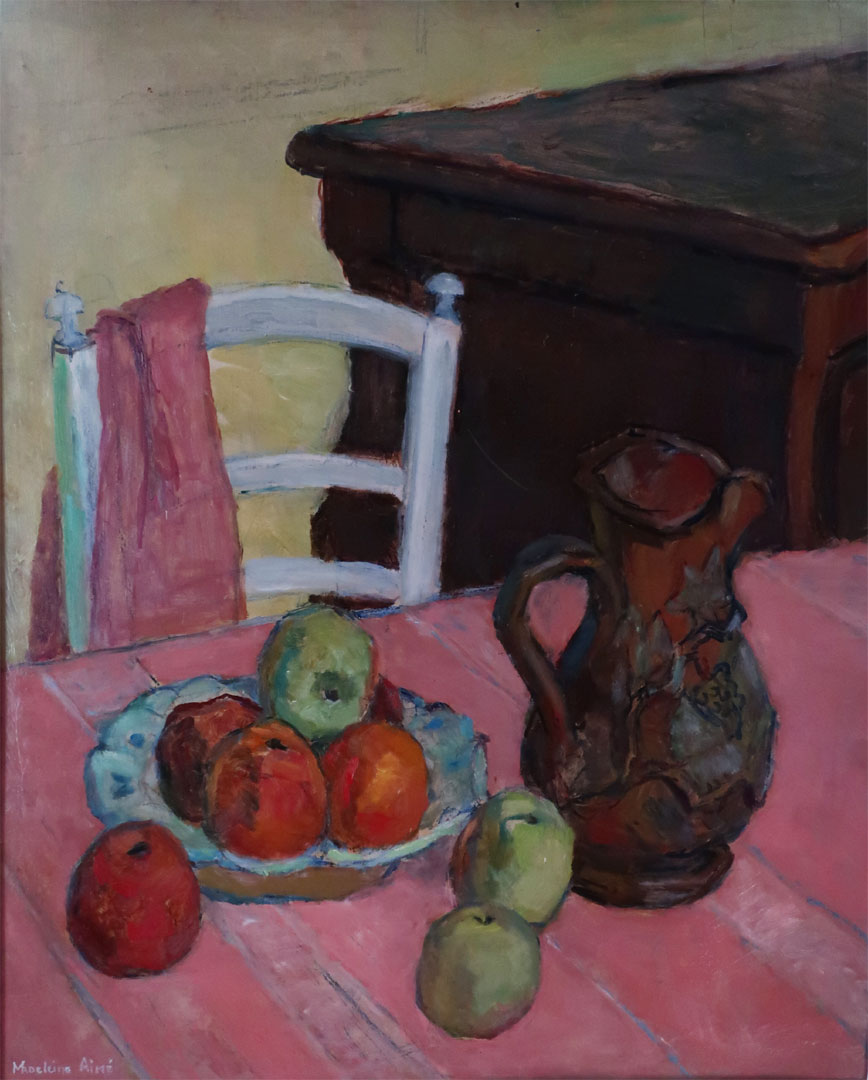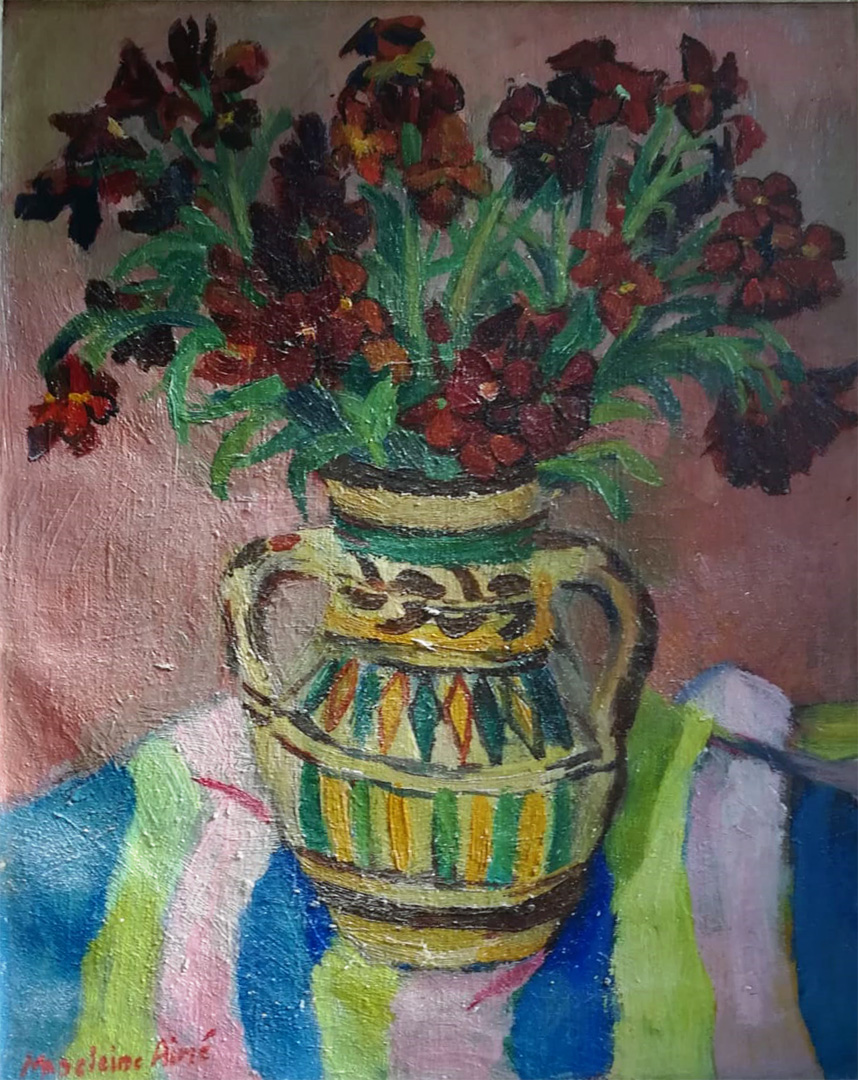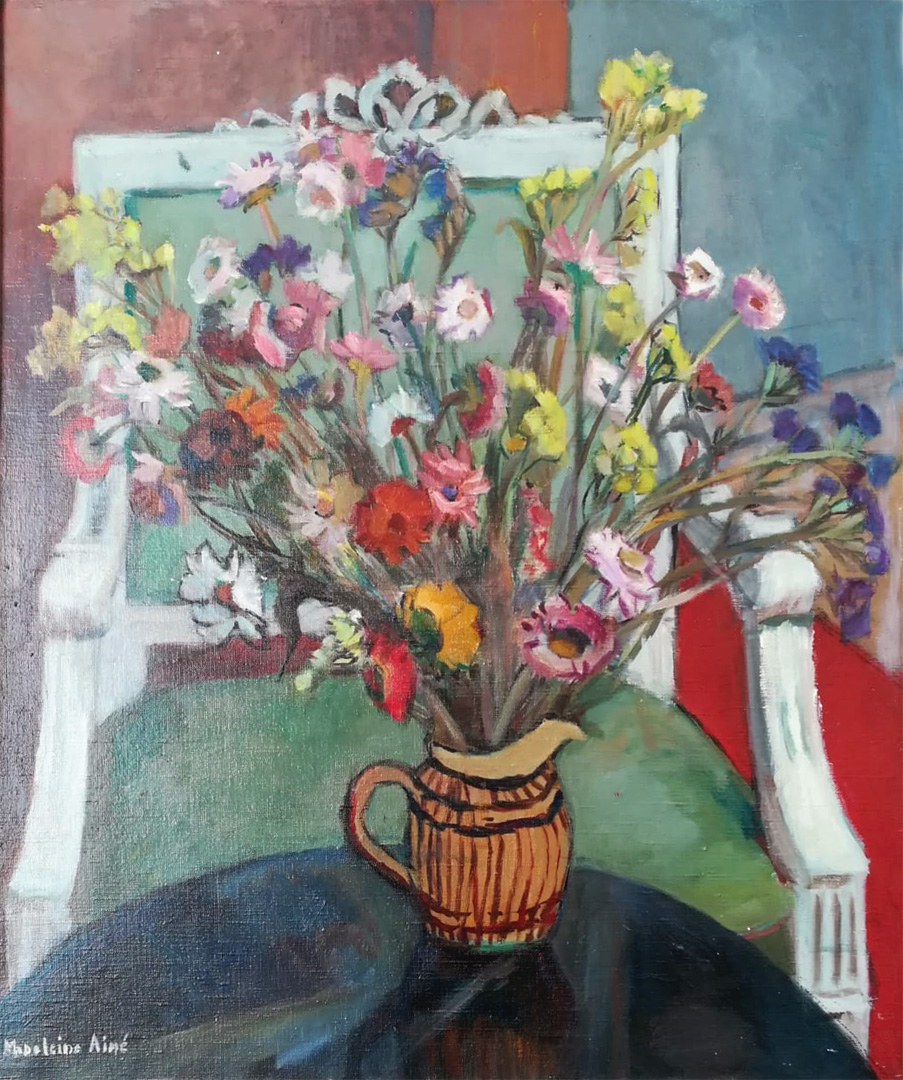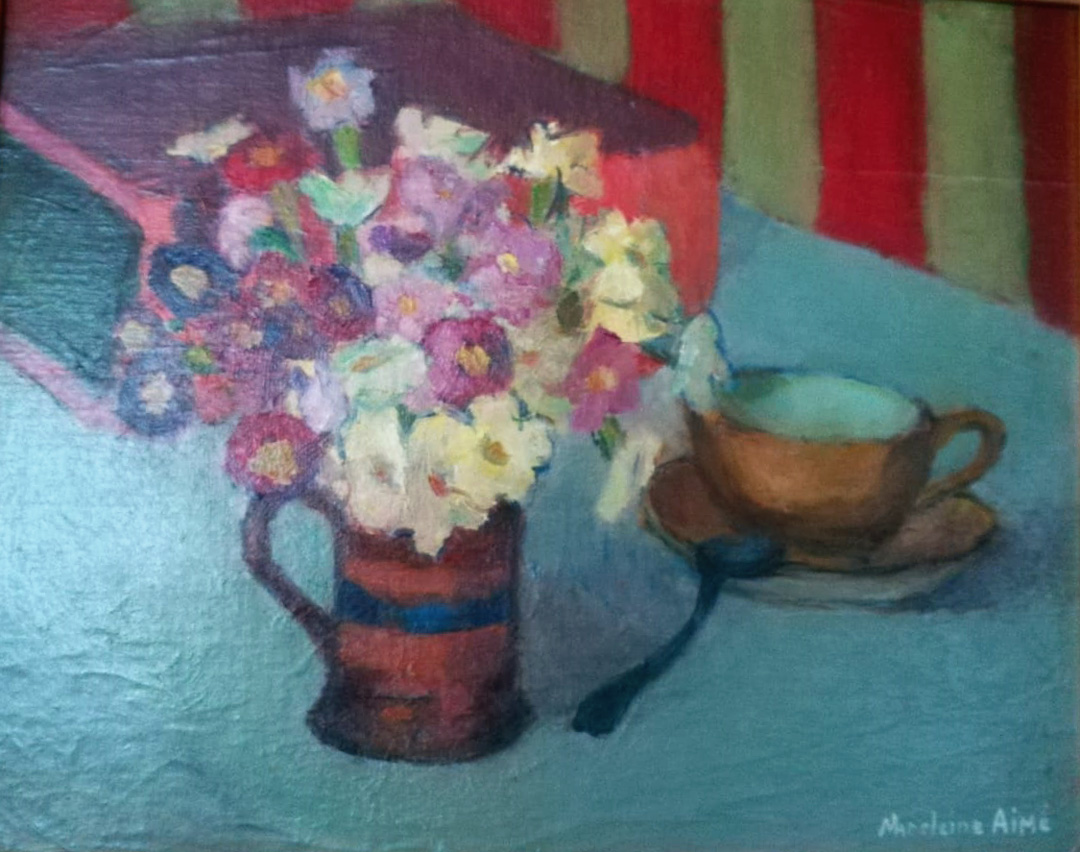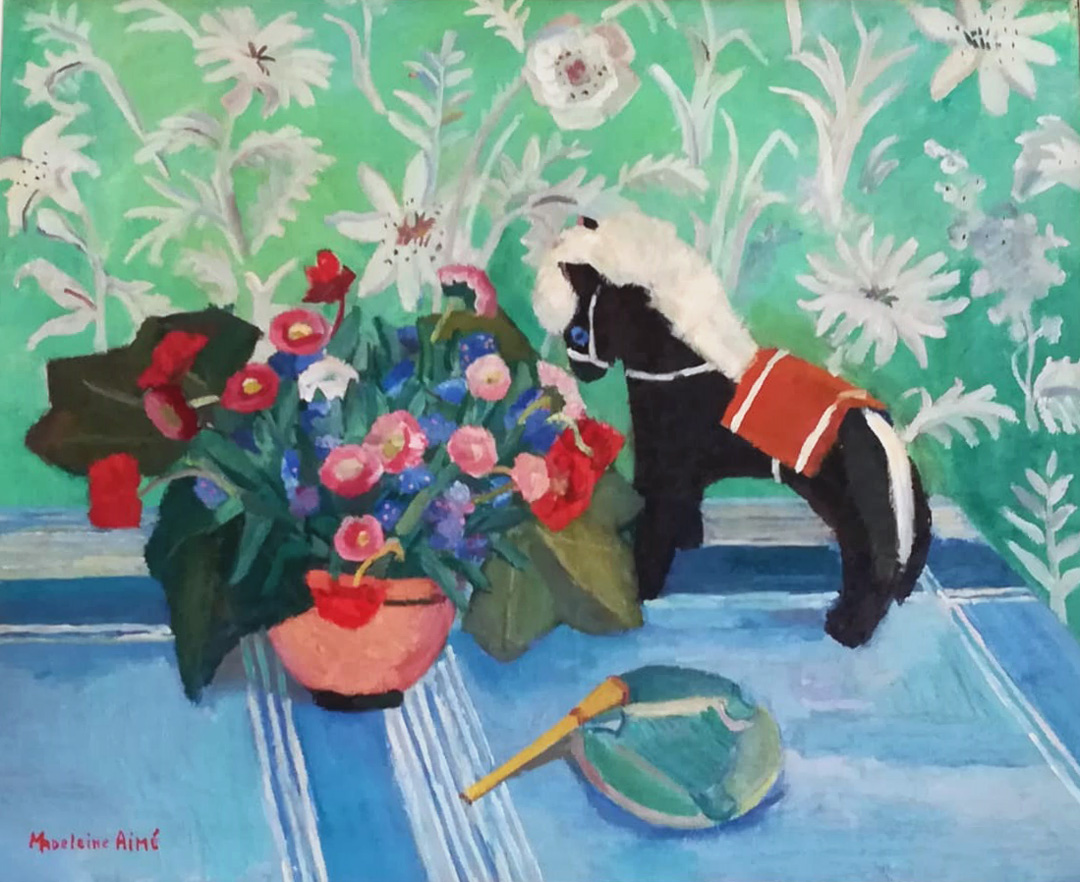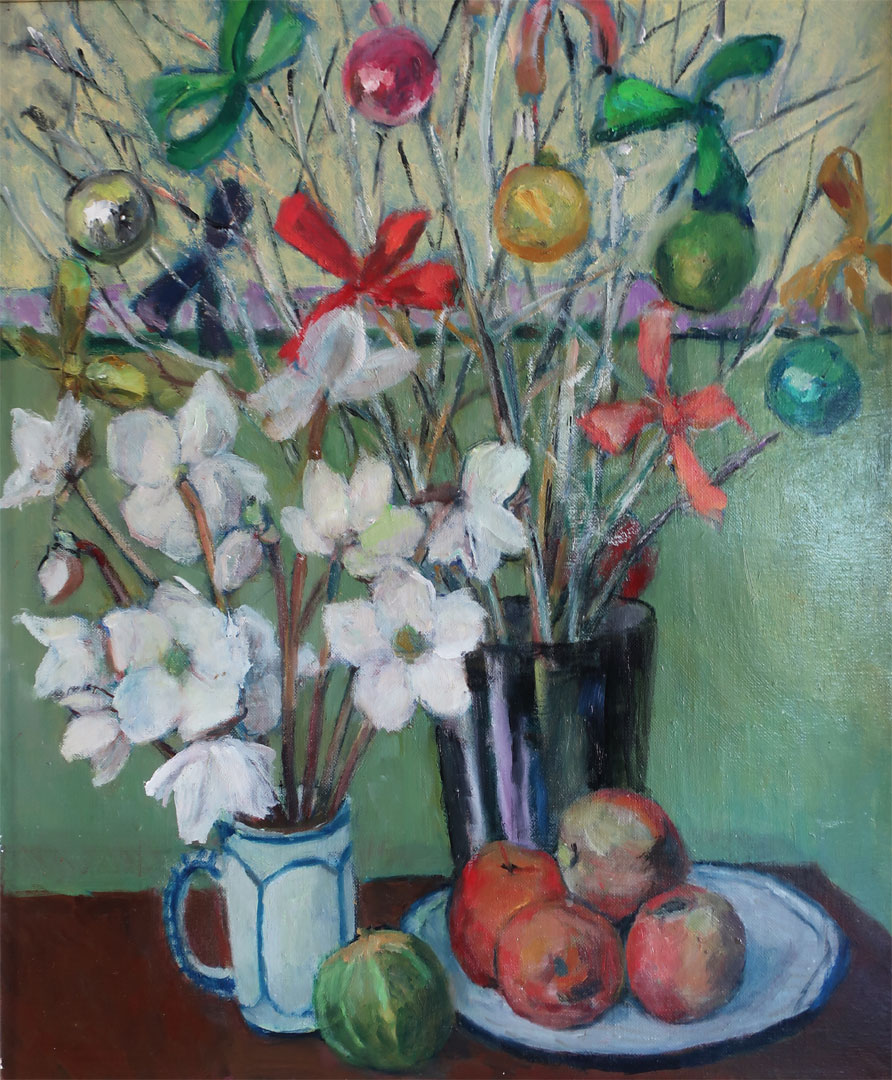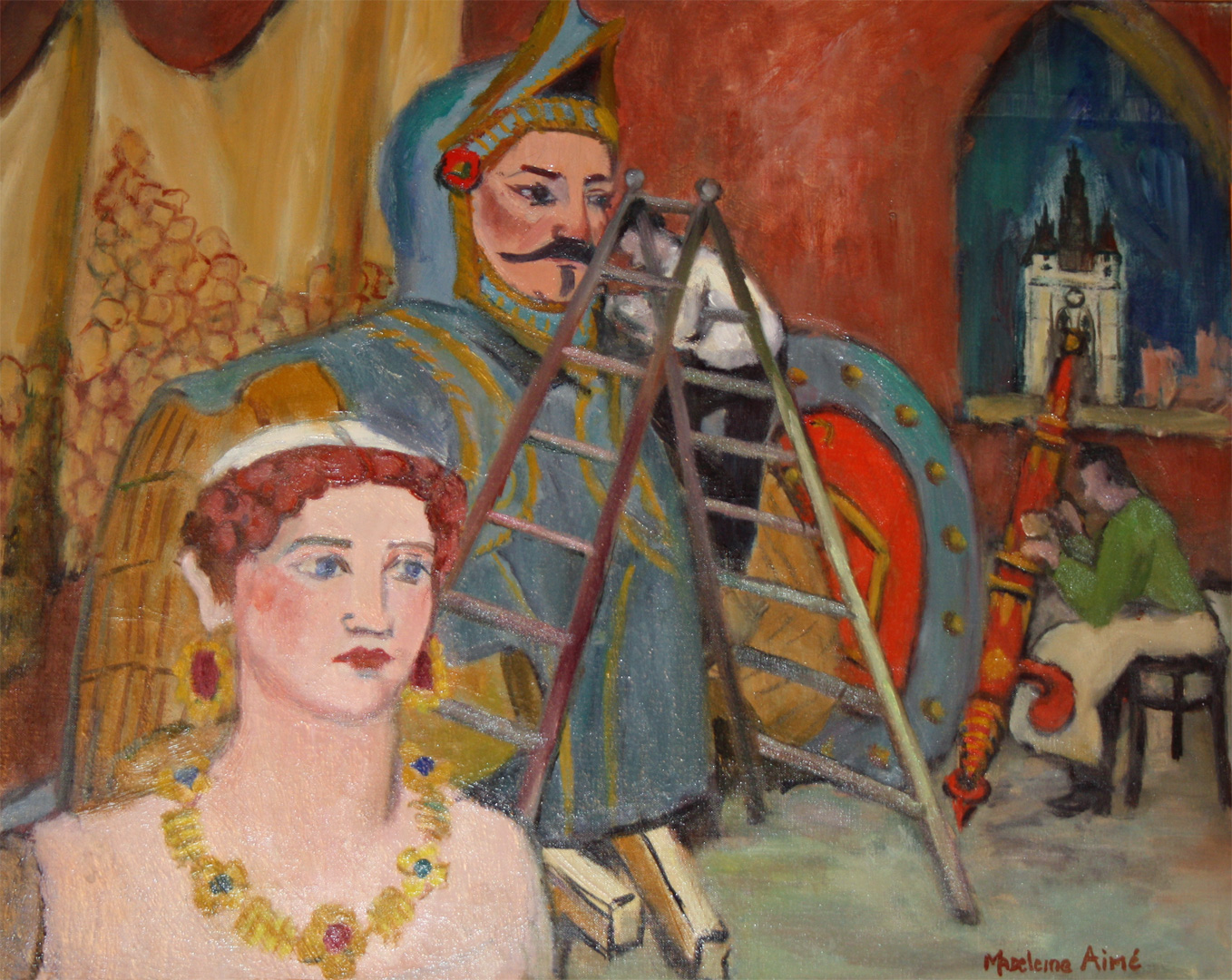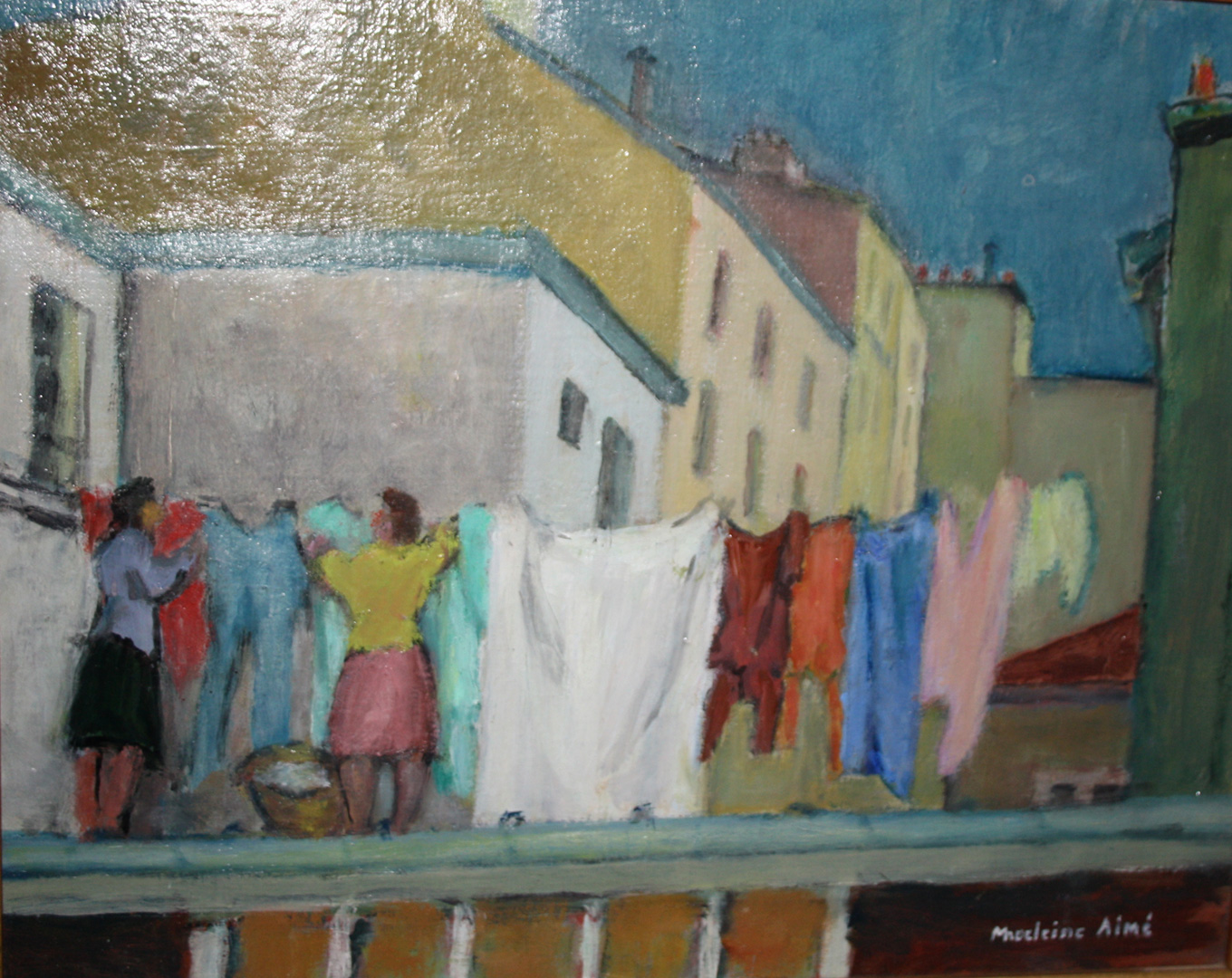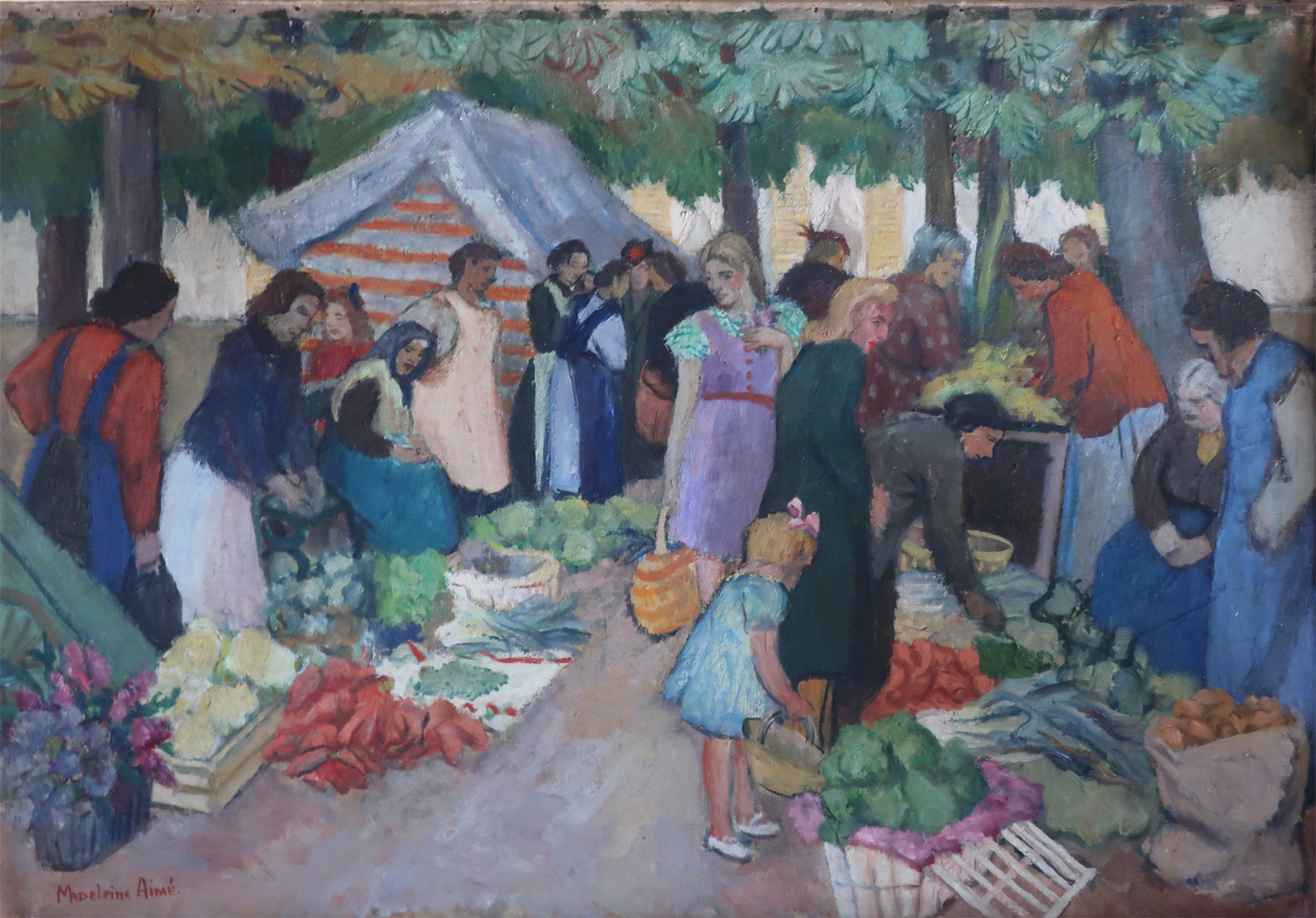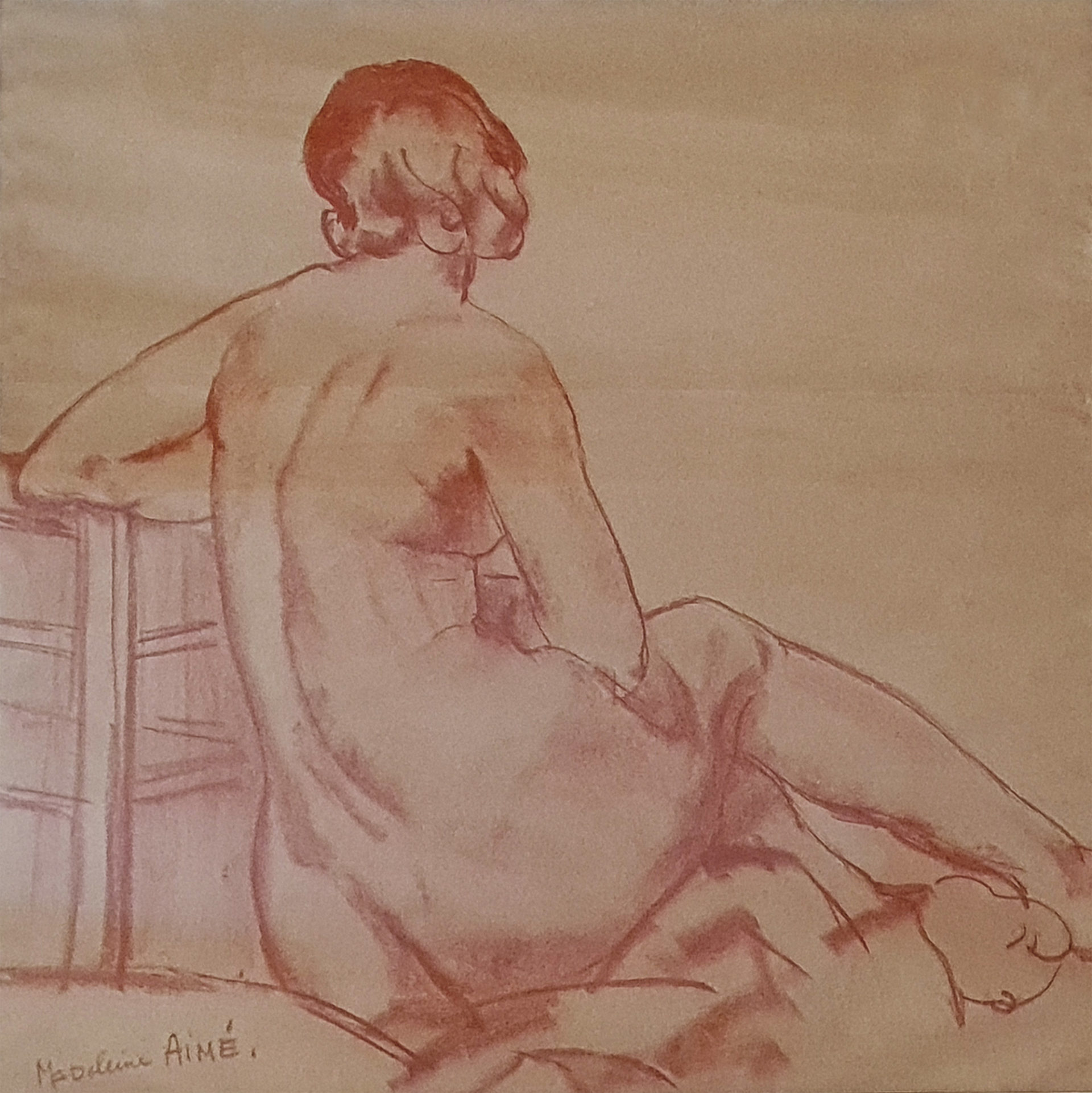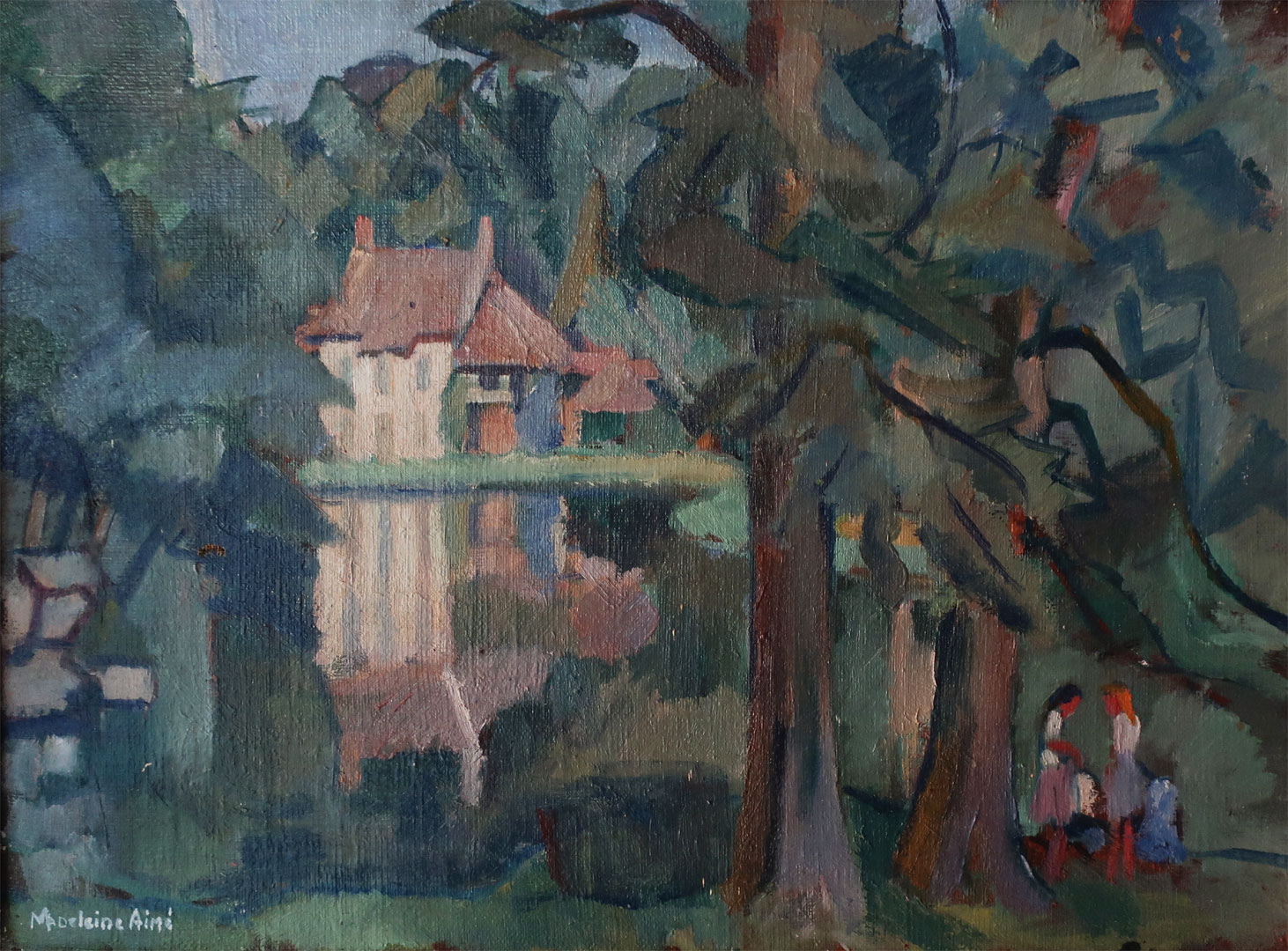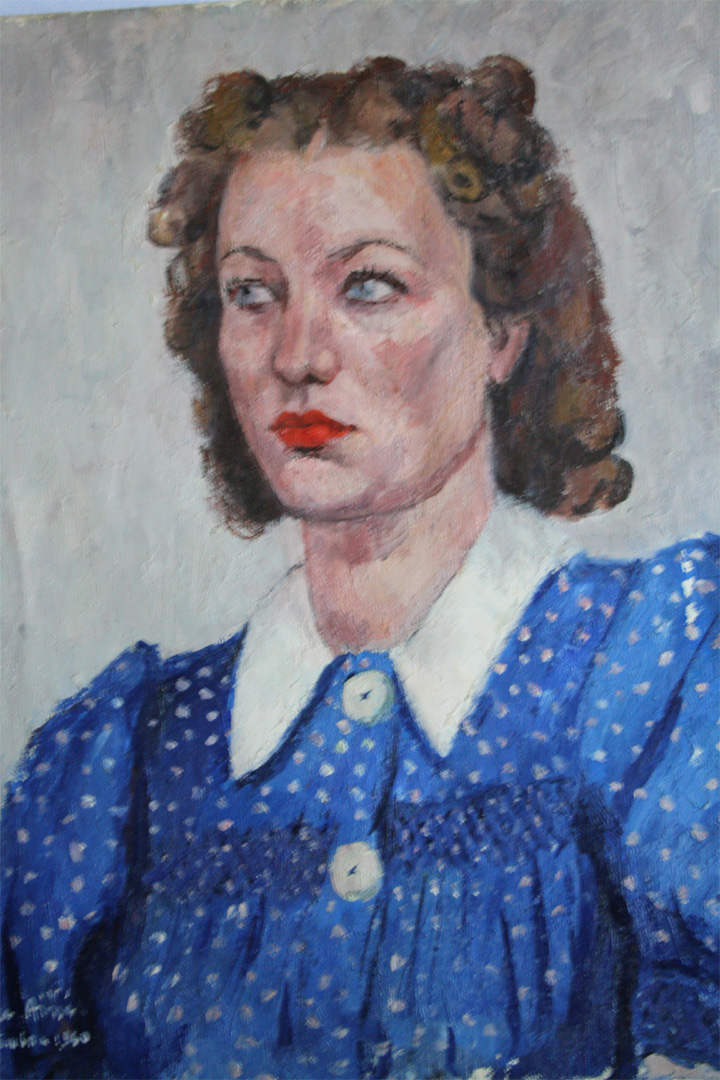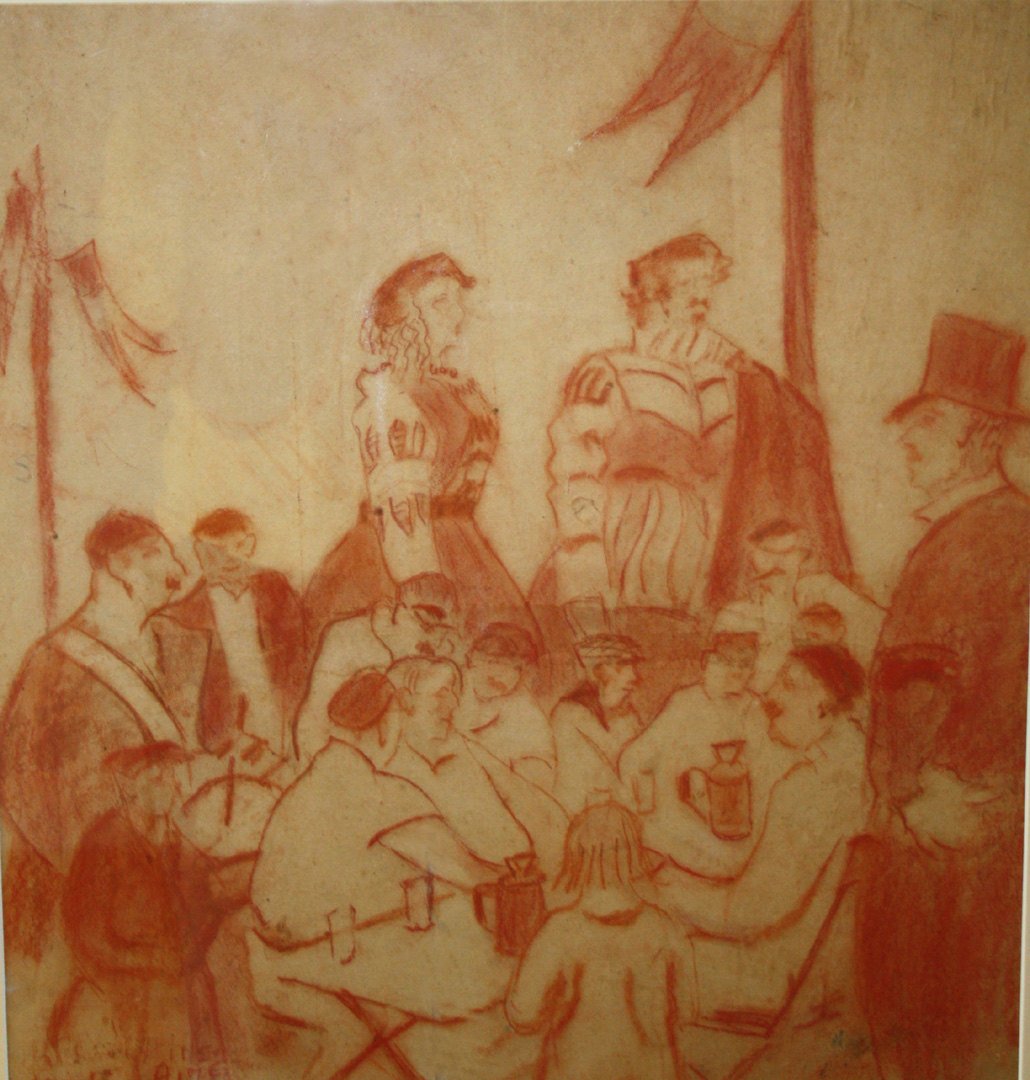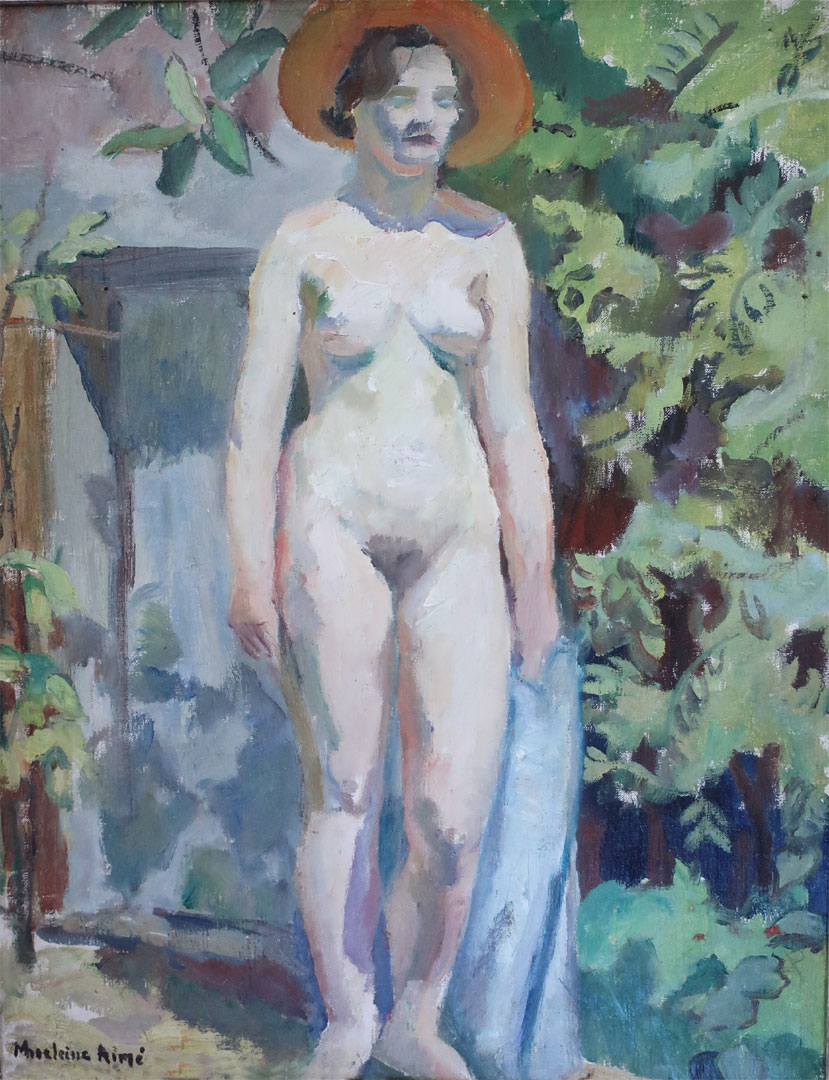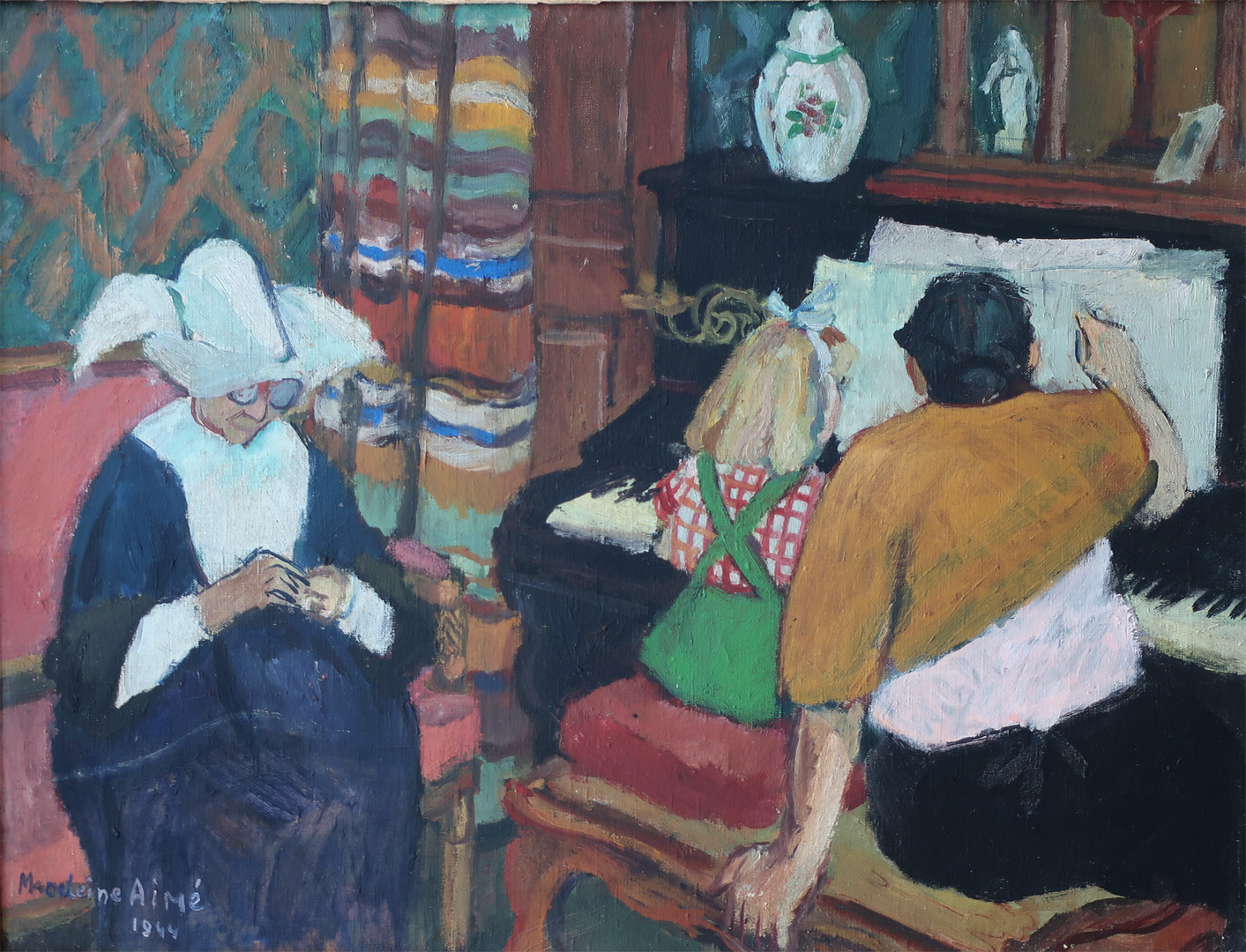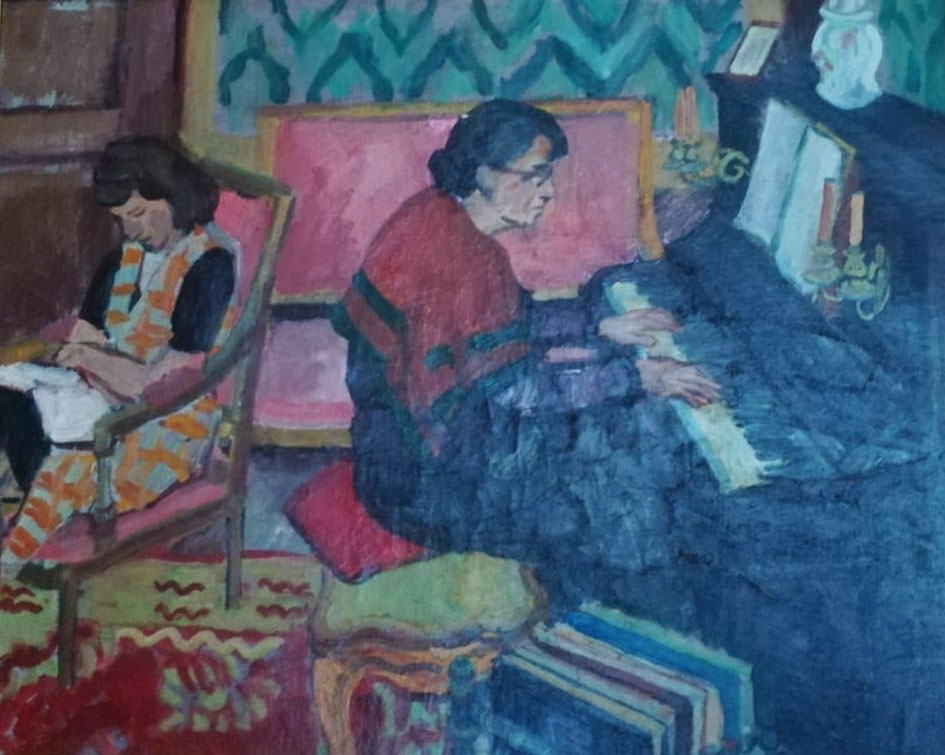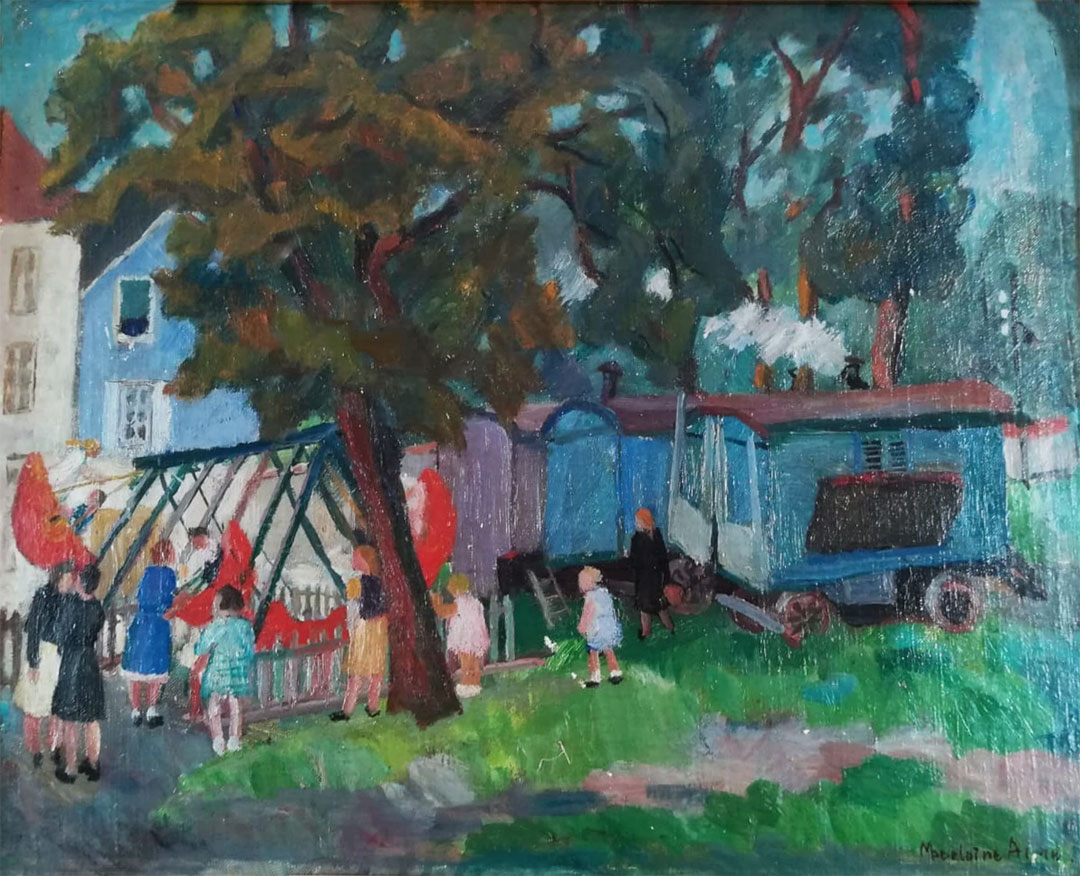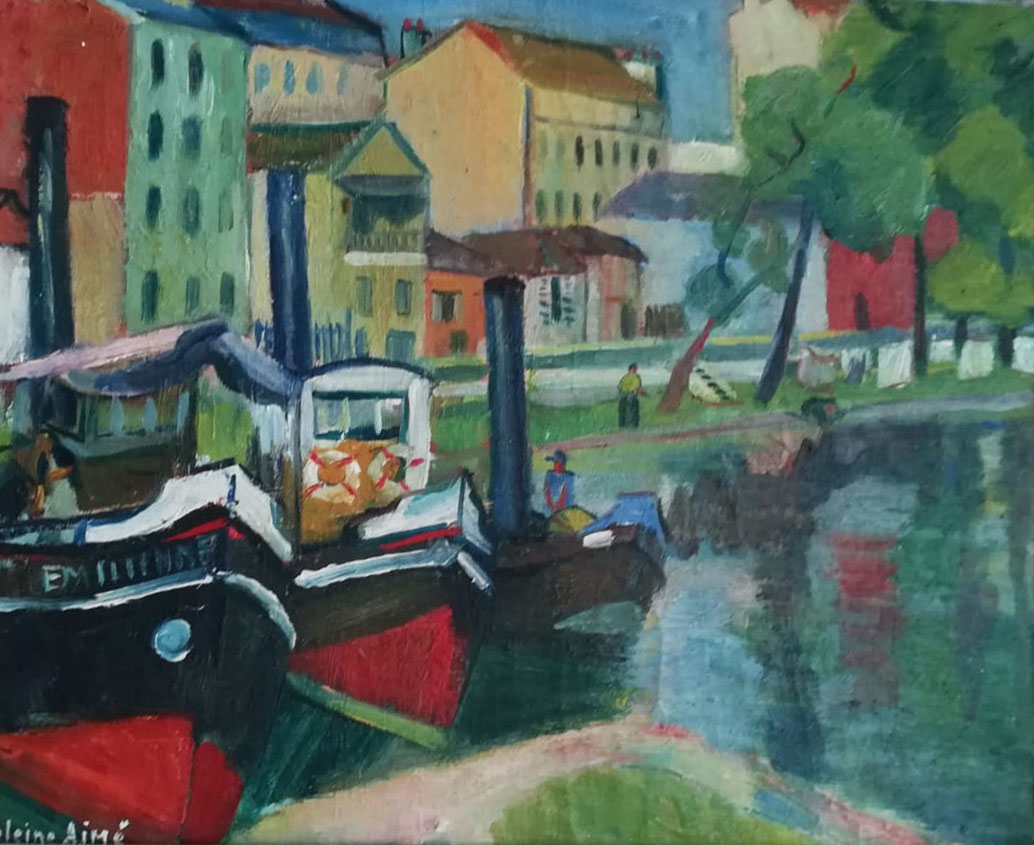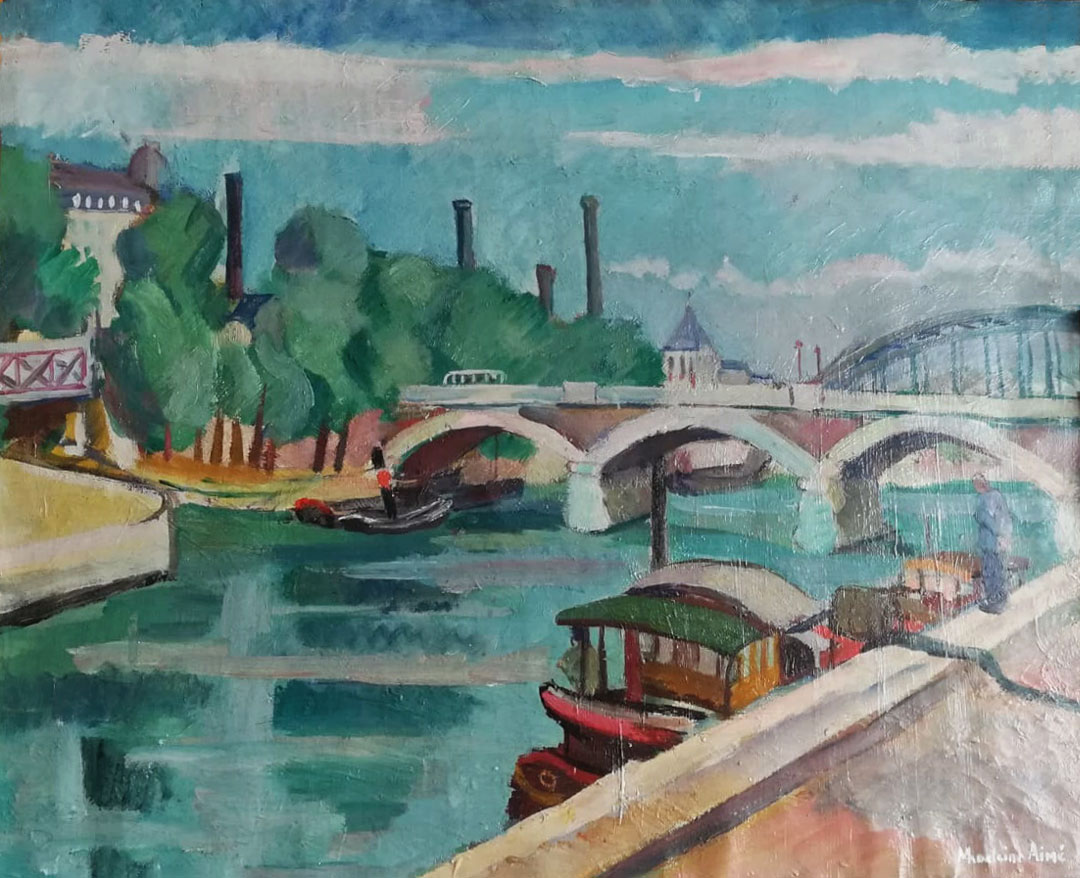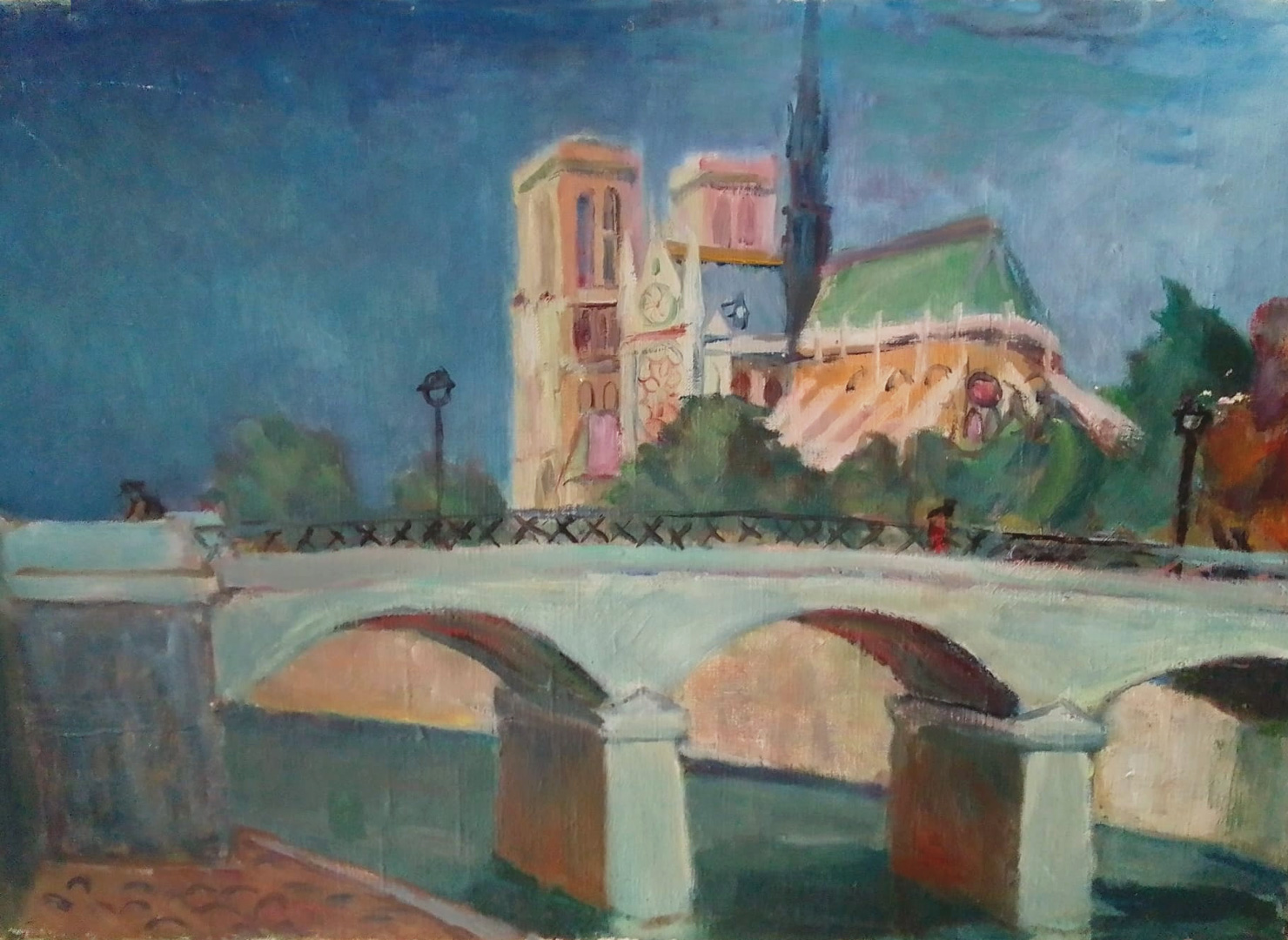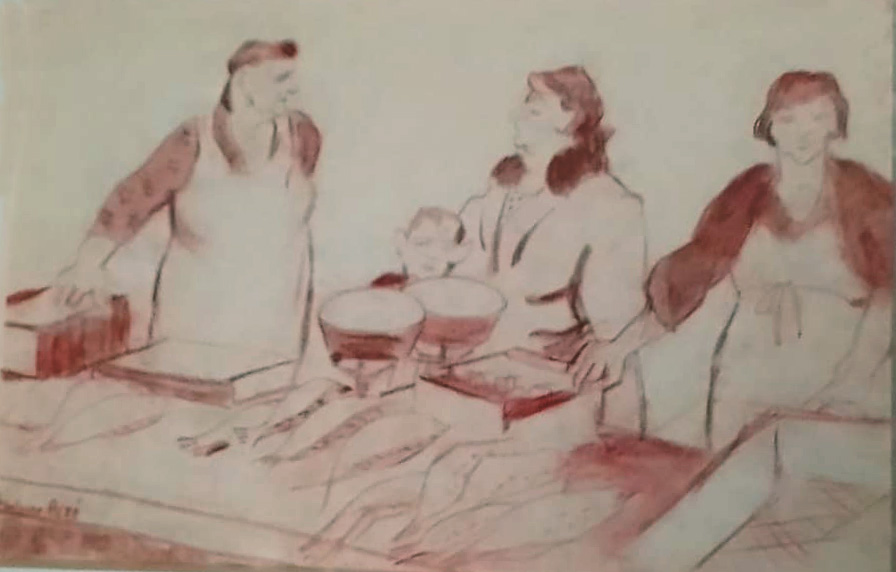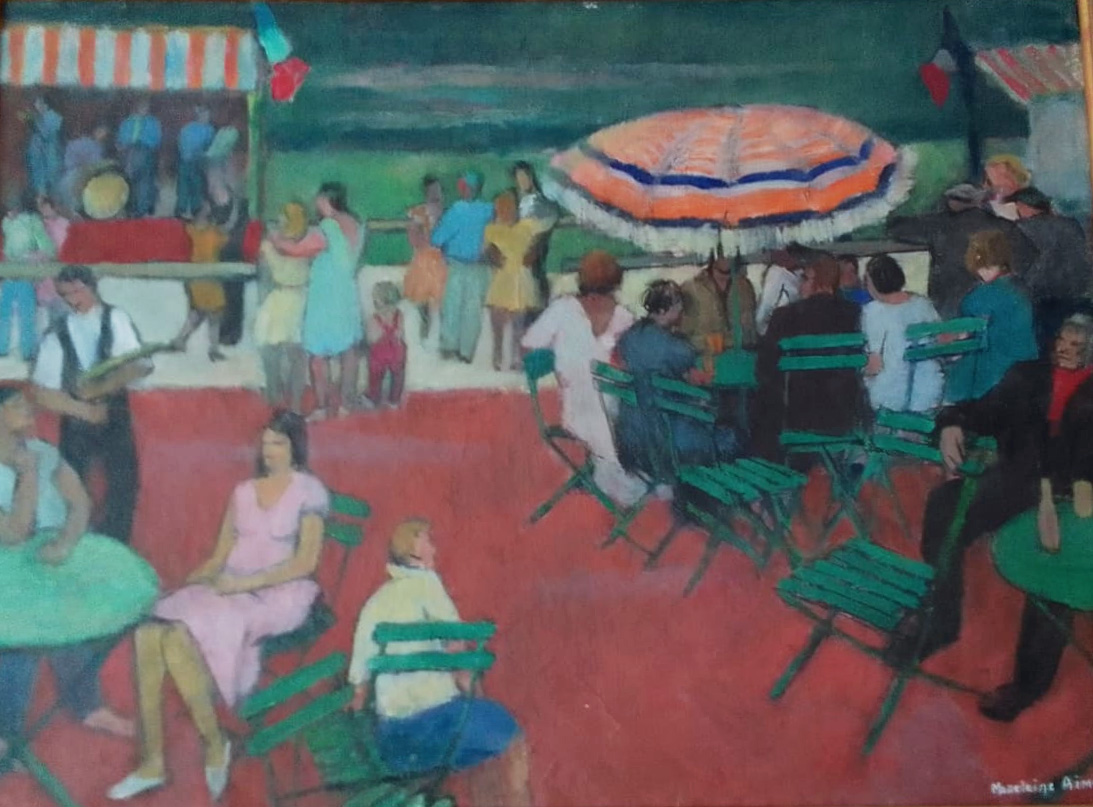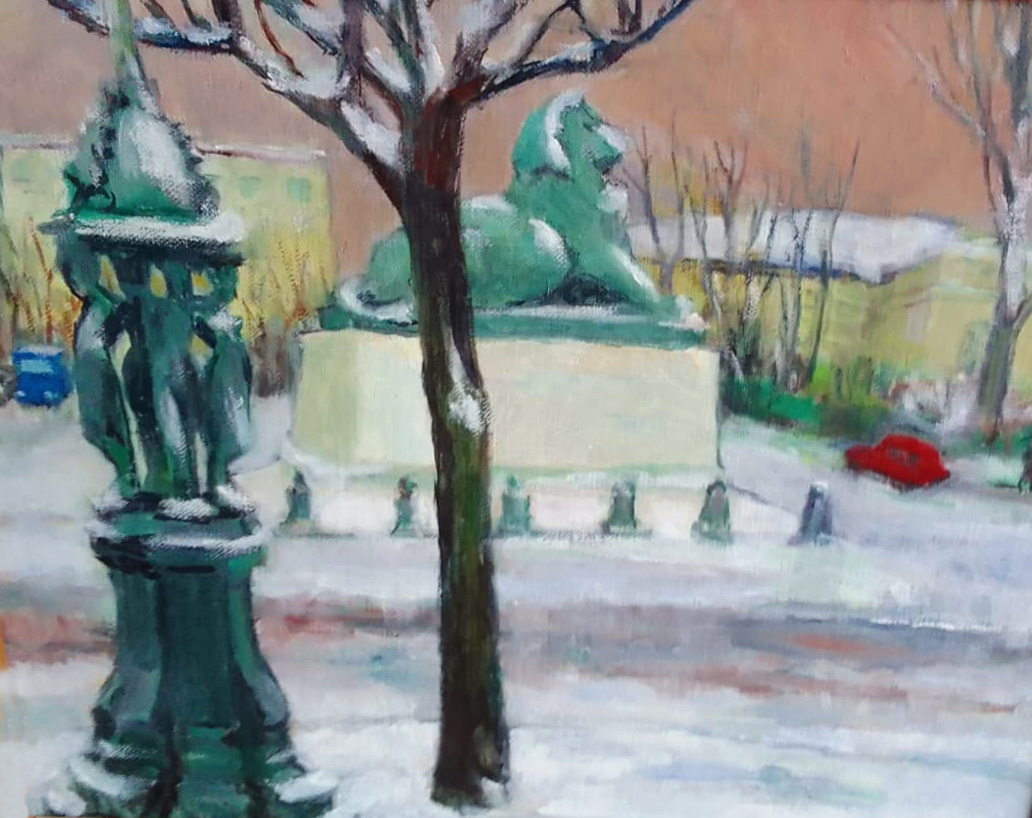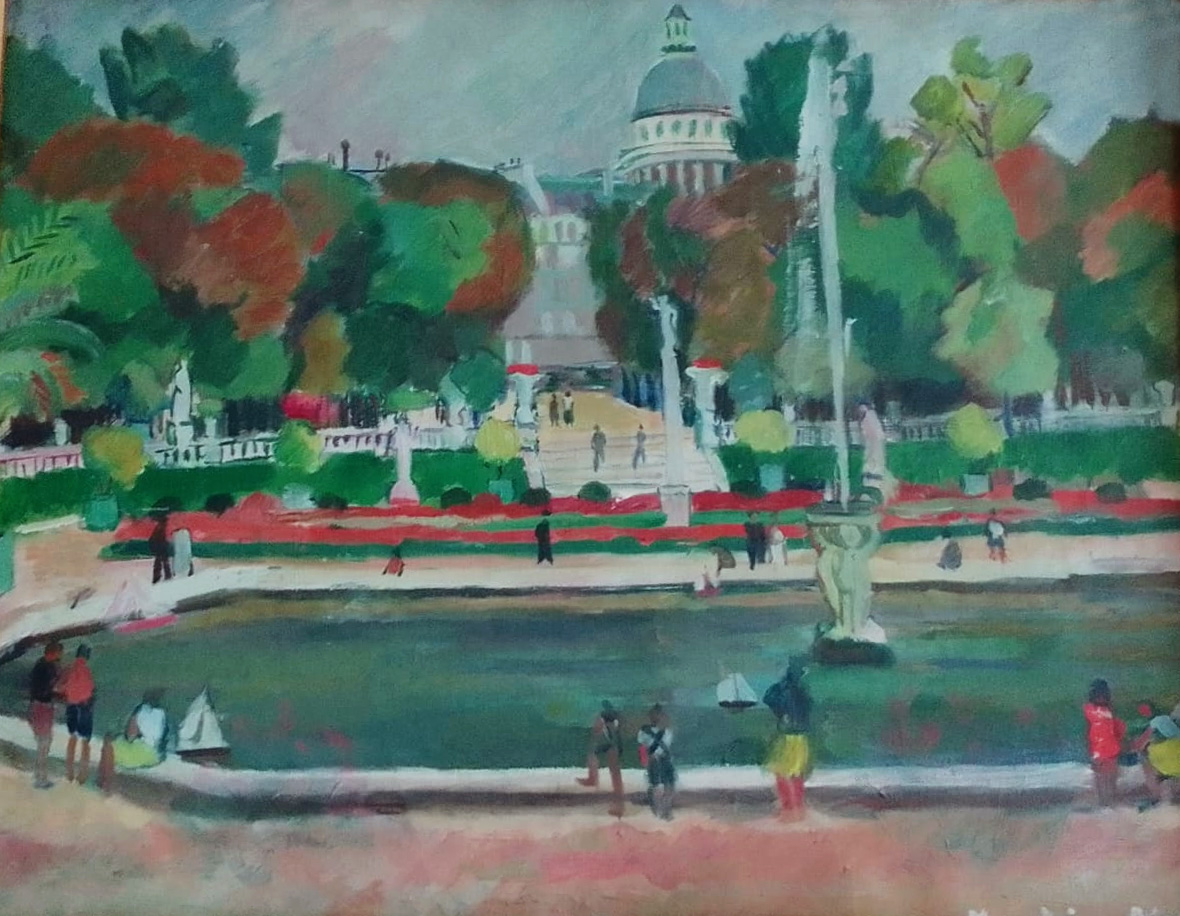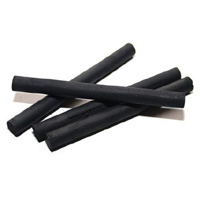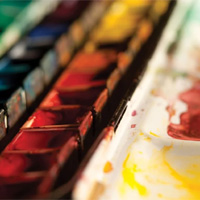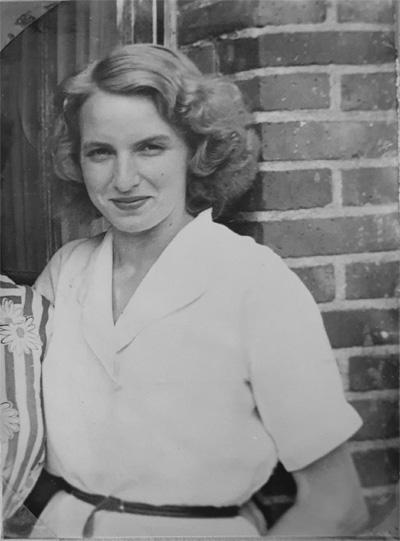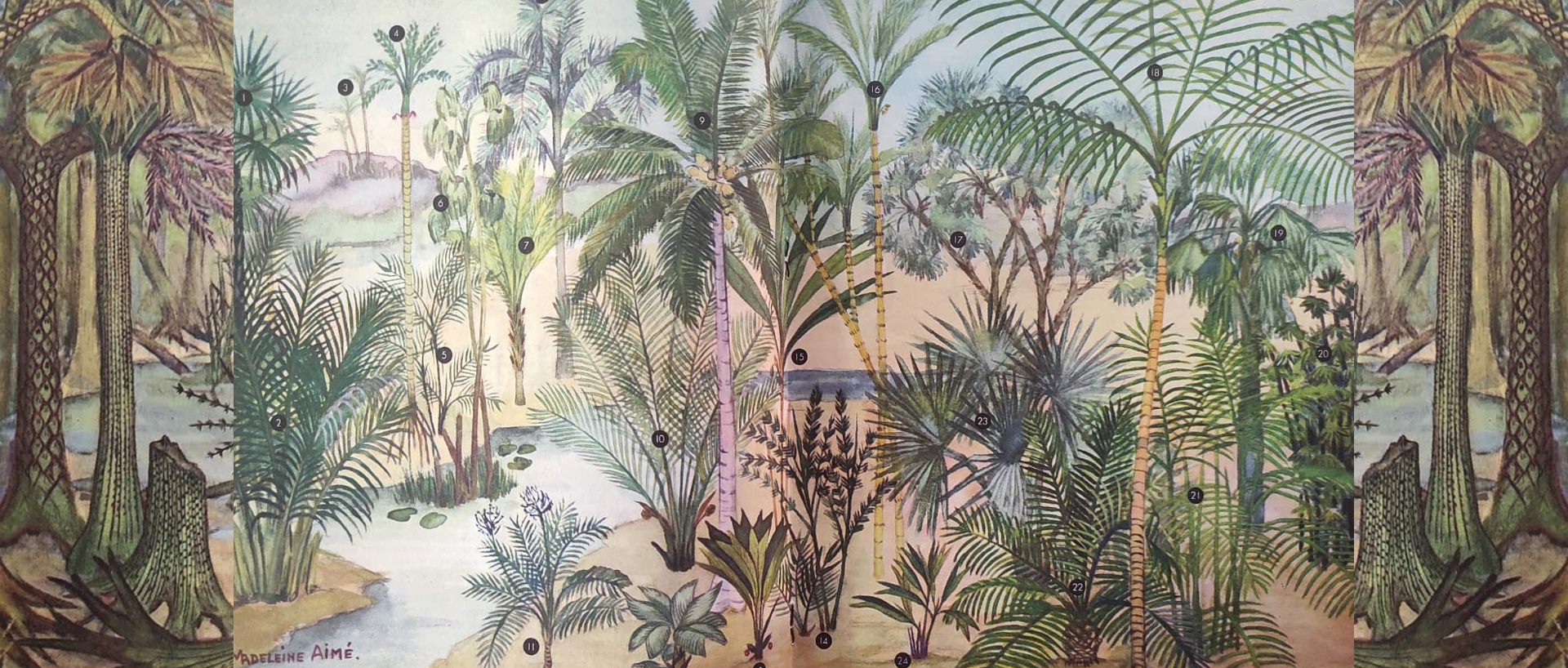
Madeleine Aimé
Anchoring in Douai

Madeleine Aimé was born on October 17, 1904 in Douai into a family of artists. This family soil and her Douai roots have strongly influenced her work.
Madeleine Aimé’s family
Maurice AImé (1877 – 1956), his father, was a painter-decorator, he also owned a building painting business.
Charlotte Aimé (1881 – 1968), his mother, a drawing teacher, studied at the Beaux-Arts de Douai in the studio of Georges Bourgogne and in the studio of Fernand Sabatté (1874 -1940) when he was teaching in Lille (between 1926 and 1929). She became a member of the Salon des Artistes Français.
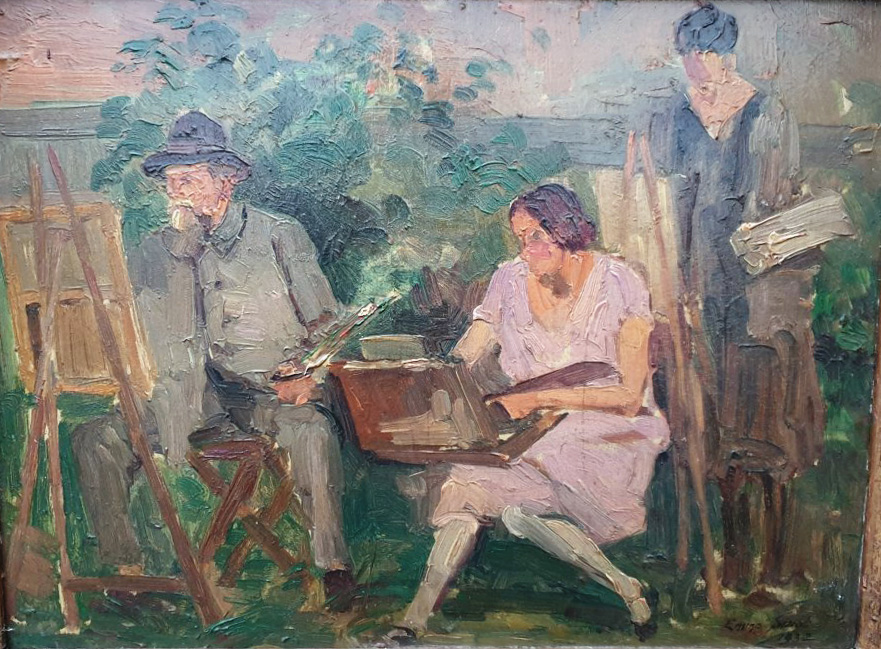
Emma Sirot
N° inv. : 2021.11
©Douai, Musée de la Chartreuse
In the foreground – Madeleine Aimé
On the left – Henri Rogerol
On the right – Charlotte Aimé, mère de Madeleine
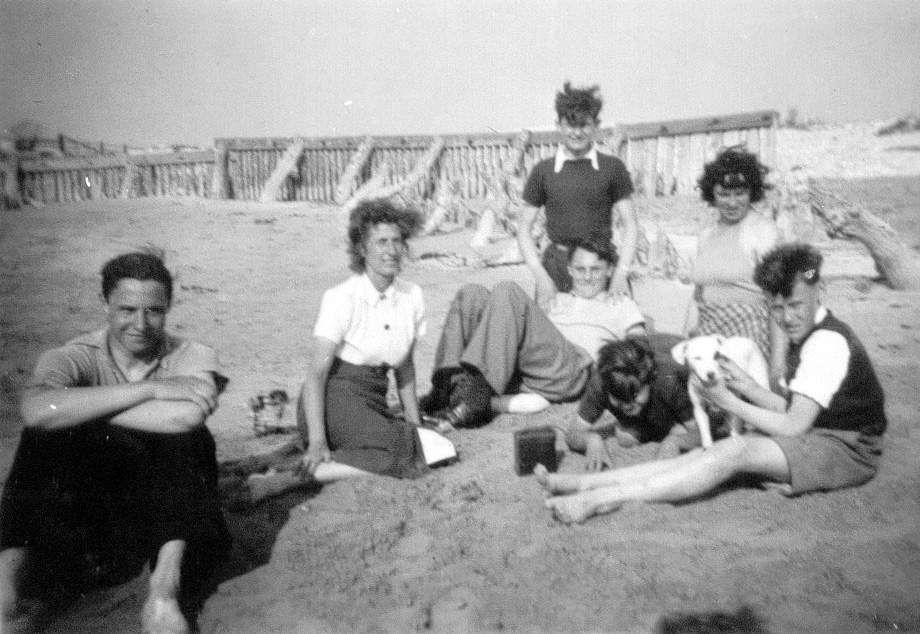
Léonce, Simone, Charles, Madeleine, Maurice
At the back Jean Boutrois
©familleAime
Simone Aimé (1907 – 1950), her sister, a drawing teacher, studied at the Beaux-Arts de Douai. She also exhibited at the Salon des Artistes Français. She became interested in photography and worked at the Douai photographer Baron Frères, rue de Bellain in Douai..
Paul Aimé (1909 – 1996), her younger brother, painter-decorator, studied at the Beaux-Arts de Douai in the studio of Florent Méreau (1892 – 1953) and in the studio of Eugène Selmy (1874 – 1945) director of the higher courses of painting at the School of Fine Arts of Lille.
He realized many paintings of landscapes of the North and his native town of Douai. He exhibited at the Salon des Artistes Français.
Three other brothers : Charles, Léonce and Maurice, who did not choose an artistic career, are also part of this big brotherhood.
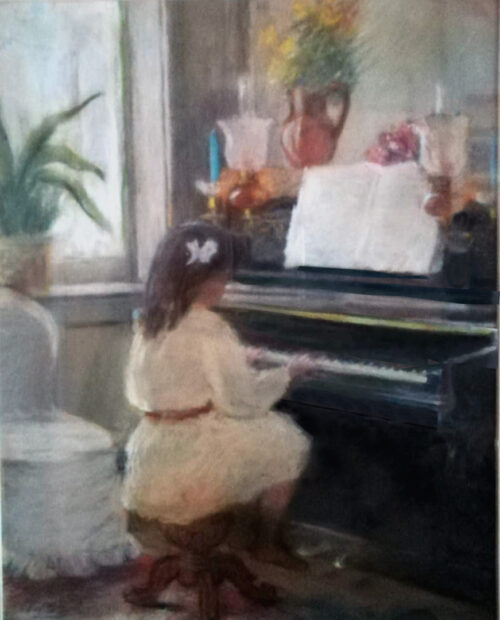

on the banks of the Scarpe river ©FamilleAime
Works of Charlotte, Maurice and Simone Aimé
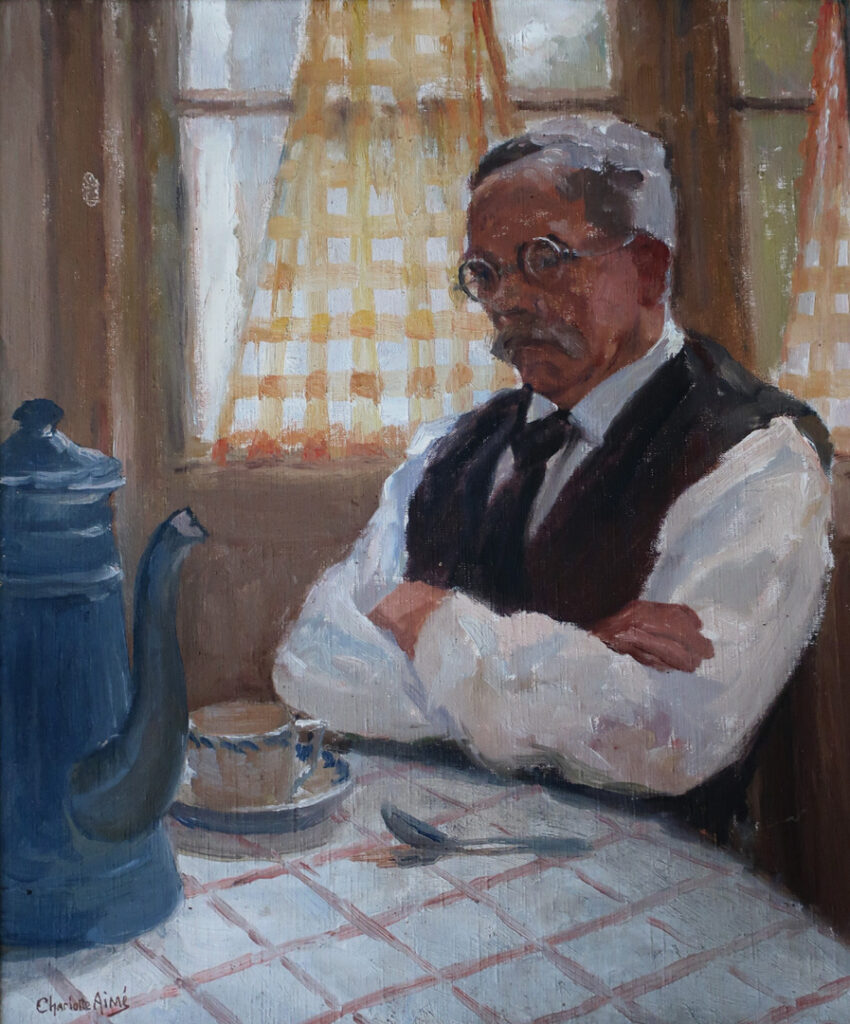
Private collection – ©FamilleAime
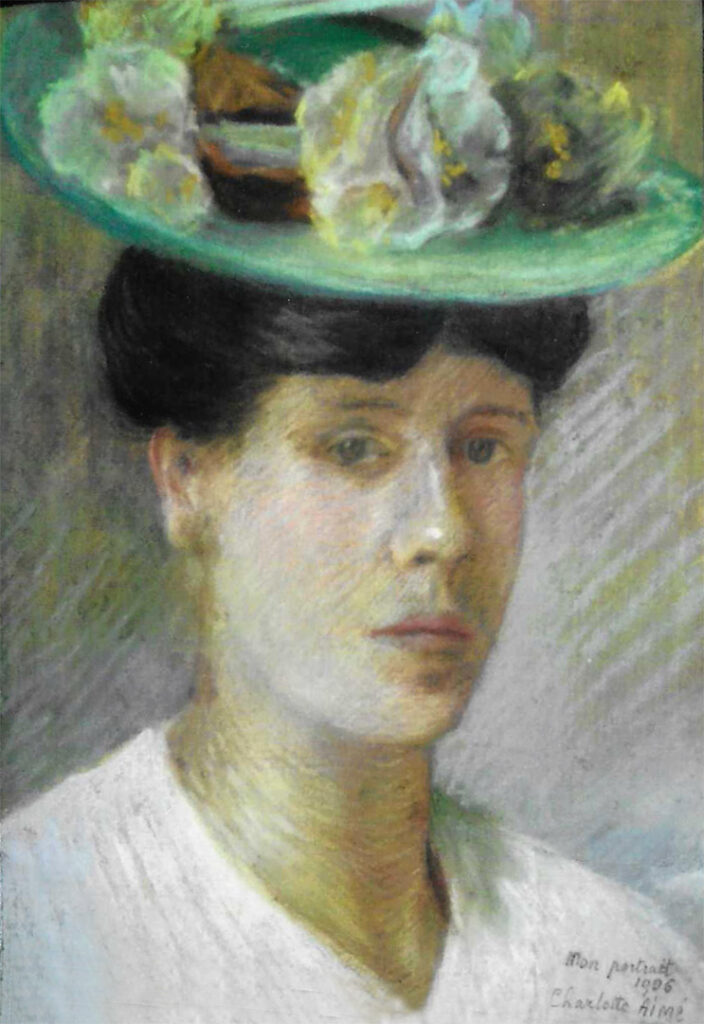
Private collection – ©FamilleAime
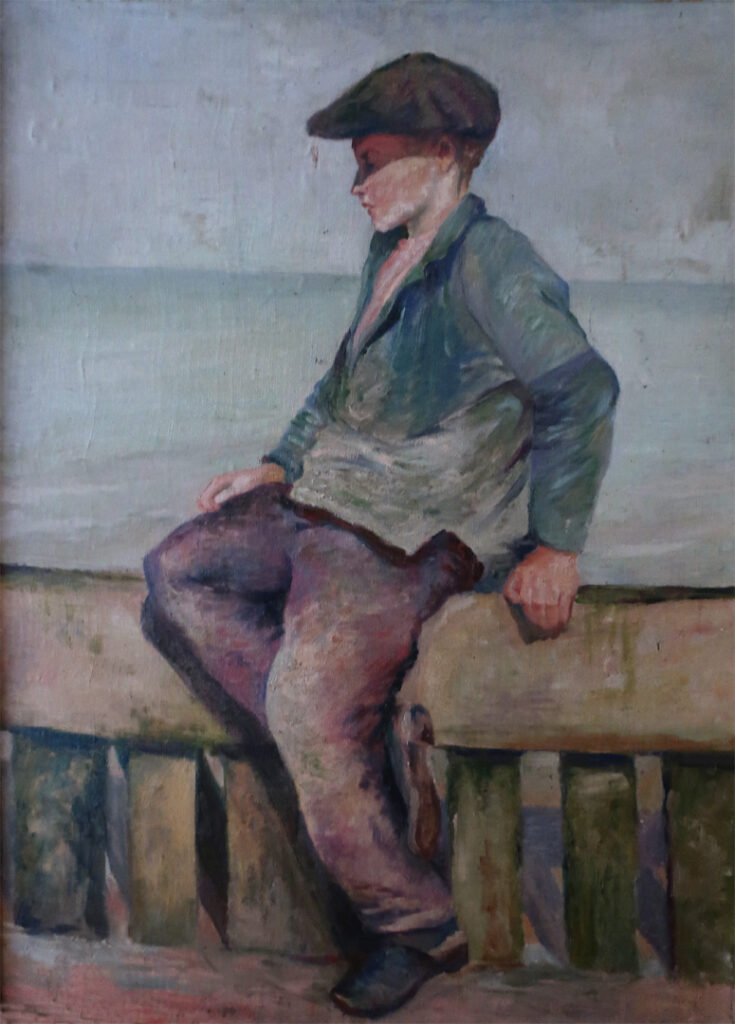
Private collection – ©FamilleAime
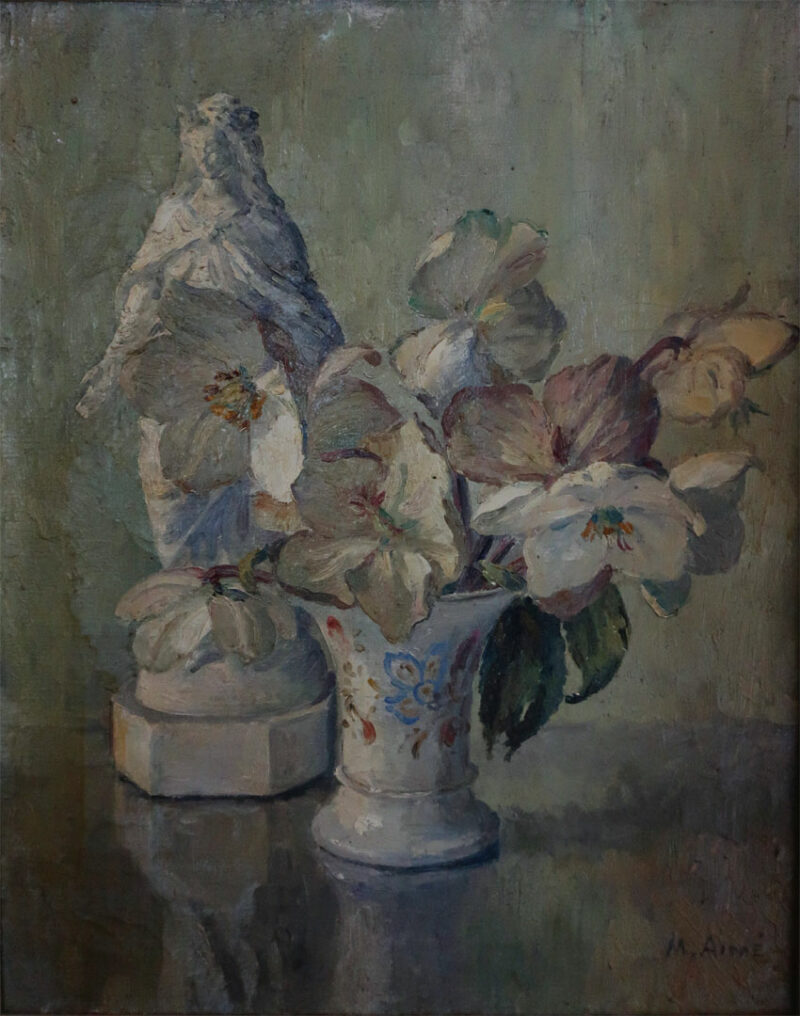
Private collection – ©FamilleAime
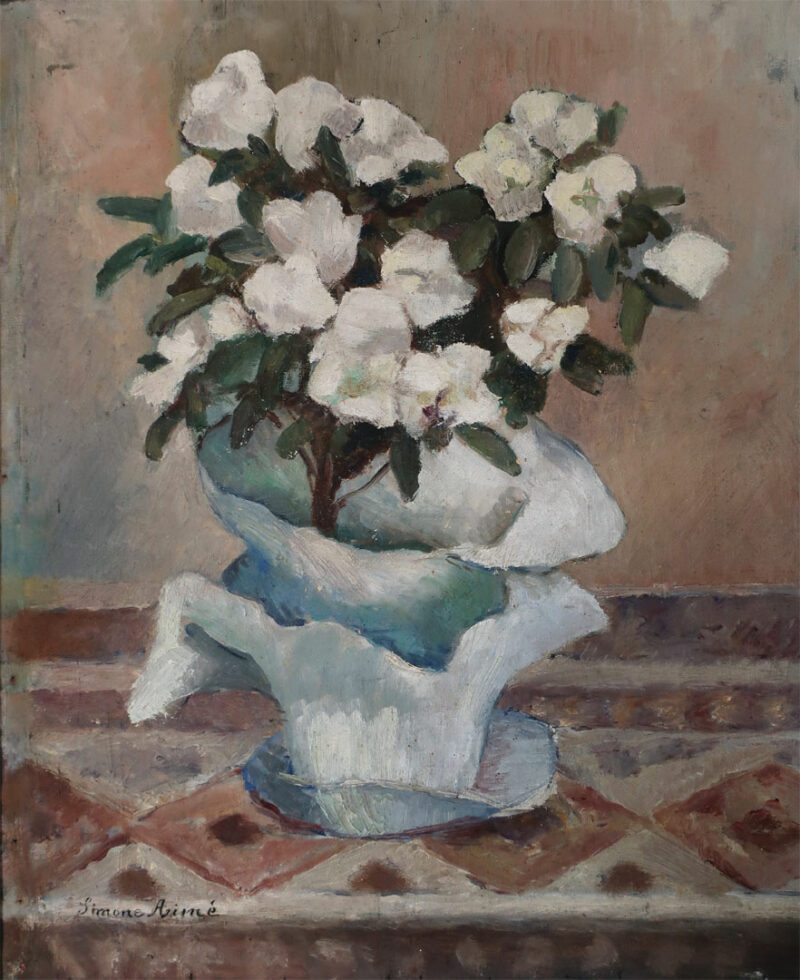
Private collection – ©FamilleAime

Private collection – ©FamilleAime
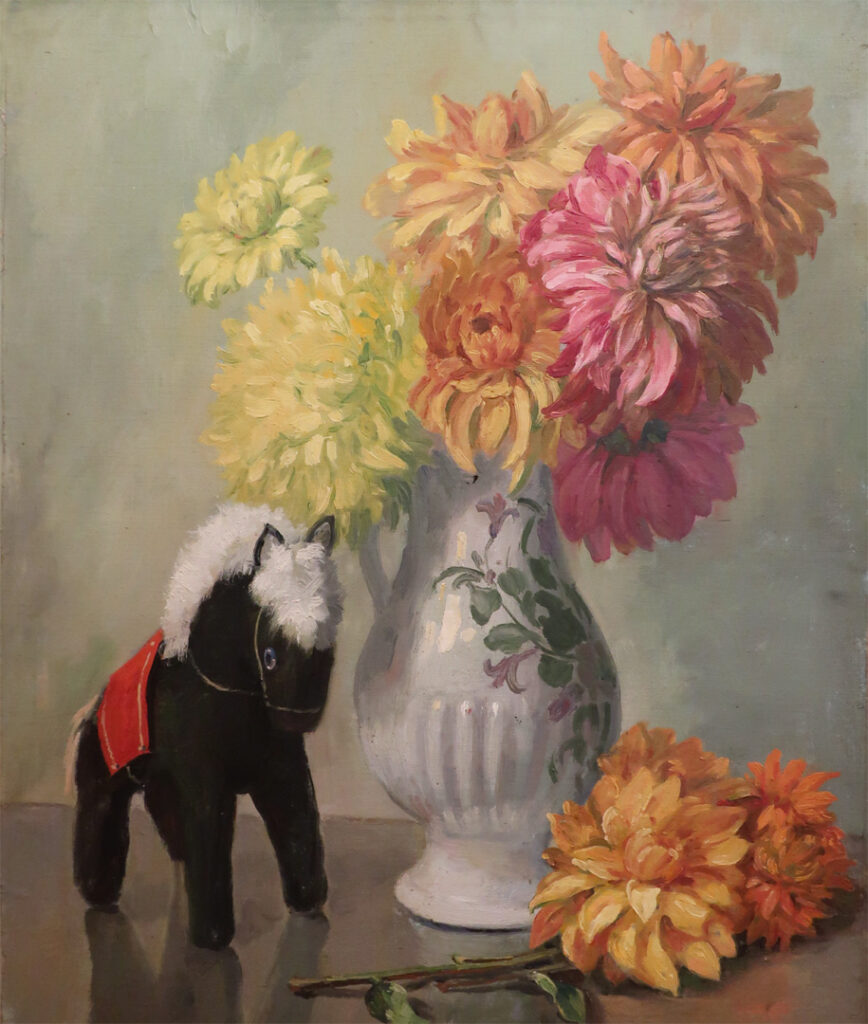
Private collection – ©FamilleAime

Private collection – ©FamilleAime
The unmissable Gayant
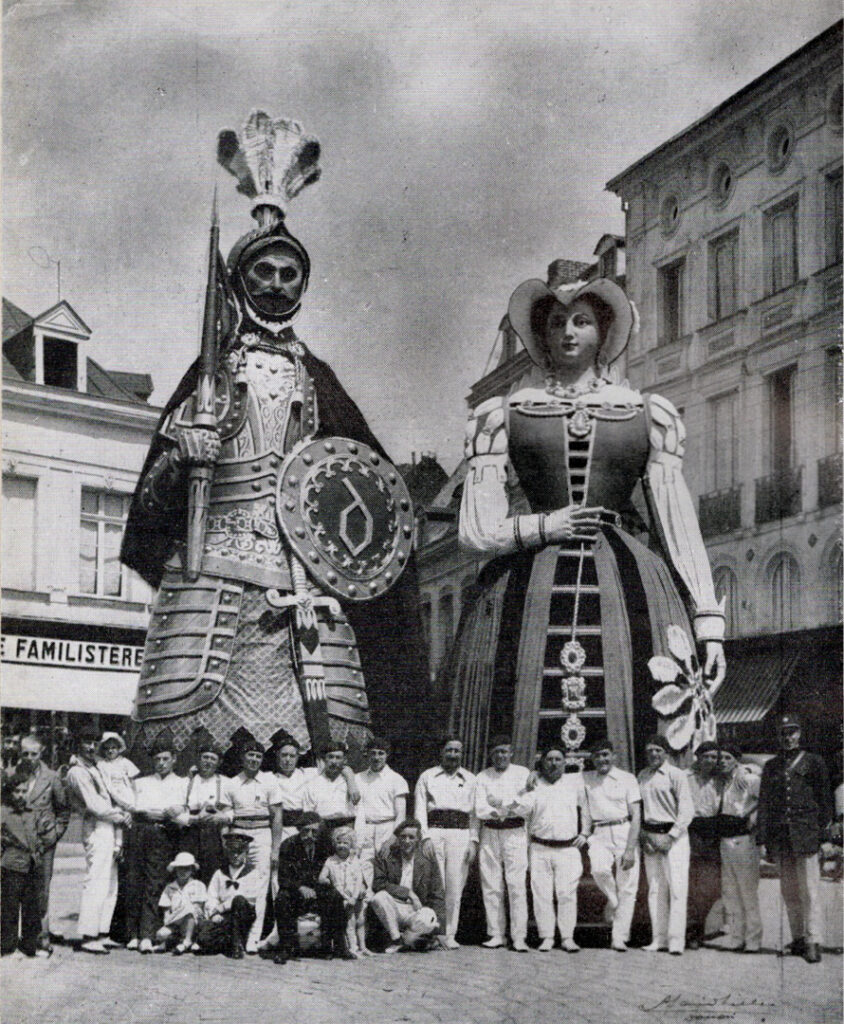
Mr. and Mrs. Gayant and their bearers
Edition 1953 – n° 10 Guide pratique S.I. – ©Douai
The Aimé family was very involved in the rebirth of the Gayant giants, destroyed during the bombing of Douai in 1940. In particular, Maurice Aimé is known for his participation in the restoration (painting and decoration) of Mr. and Mrs. Gayant from 1953.
Not surprisingly, the theme of Gayant recurs in the family’s works.
Nowadays, Gayant is still an annual event, dear to the heart of the inhabitants of Douai, so much so that the terms “Enfants de Gayant” or “Vint’s d’osier” (wicker bellies) have become synonymous with “Douaisiens”.
During the Gayant festivities, wicker giants parade through the streets of Douai. They are the “carriers of Gayant” who ensure the movement of the giants on their shoulders. This is one of the particularities of this procession.
In the Gayant family we find :
– The father, Mr Gayant
– The mother, Marie Cagenon
– The 3 children : Jacquot, Fillion and Bimbin, the youngest, also nicknamed “Tiot Tourni” because of a rather pronounced strabismus…
Are also part of the parade, a horse of pasteboard (the “sot of the gunners”) and the “wheel of fortune” which finishes the procession.
The Gayant festivities, which are classified as a Unesco World Heritage Site, take place every year.

Private collection – ©FamilleAime
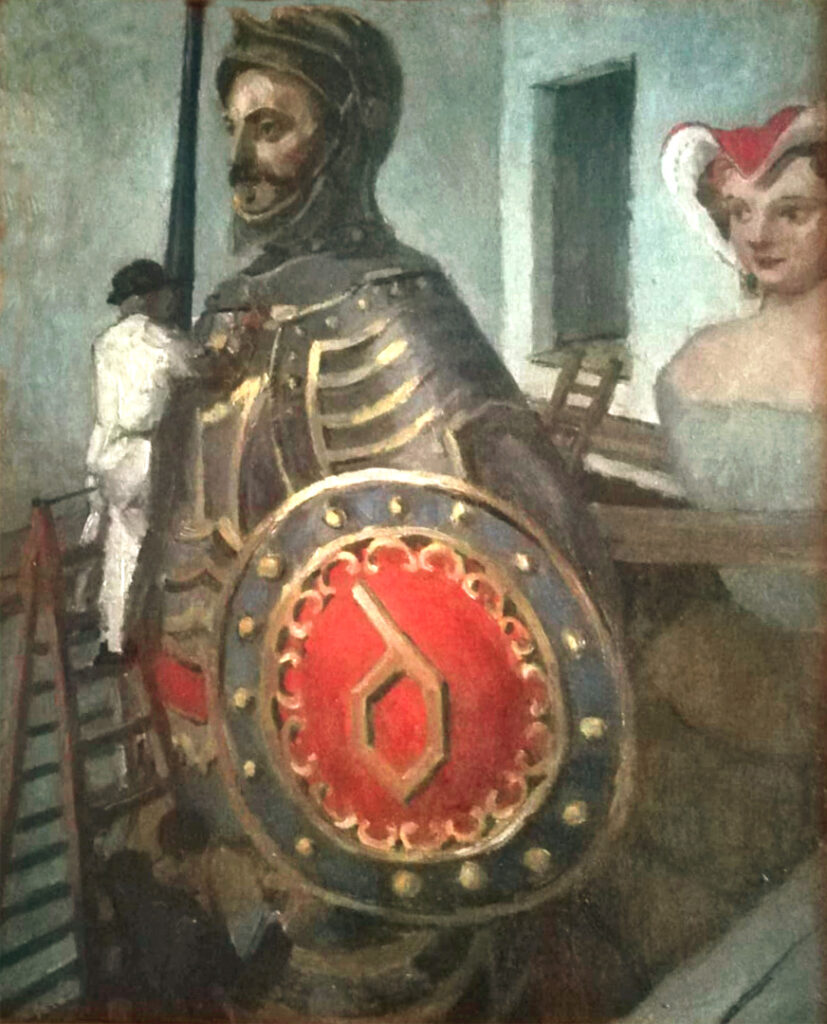
Maurice Aimé painting Monsieur Gayant
Private collection – ©FamilleAime

Private collection – ©FamilleAime
In his collection of poems Au Pays de Gayant published in 1932 by Paul Dutilleux, Paul Audebert called upon the best artists of the time, to illustrate his poems. Madeleine was one of them and produced 3 sanguines which served as a backdrop for the poems entitled « Ruisselet », « Au Barlet, “le vingt.deux”! » and « Mélancolie »
A charcoal landscape by Florent Méreau illustrates the poem “L’enfer” which speaks of the mine.
Originally from Paris, journalist by training, Paul Audebert (1875 – 1953) spent a large part of his career in the North of France and mainly in Douai which became his heart city and his source of inspiration.
The journalist was also a poet and it is his poems that made his fame.
His collection of illustrated poems Au Pays de Gayant reflects his attachment and his great tenderness for this region, its traditions and its inhabitants. No less than 40 local artists collaborated in this work.
The Gayant family has a special place in it; 3 poems: “La ballade à Gayant”, “La ballade à sa Mie”, “Le rondel à Binbin” are dedicated to it.
First quatrain of the poem “Le Rondel à Binbin”
« Et voici le joyeux Binbin
Qui roule de biais la prunelle!
Est-ce vers Lille ou vers Grenelle?
Il ne sait le gentil bambin… »
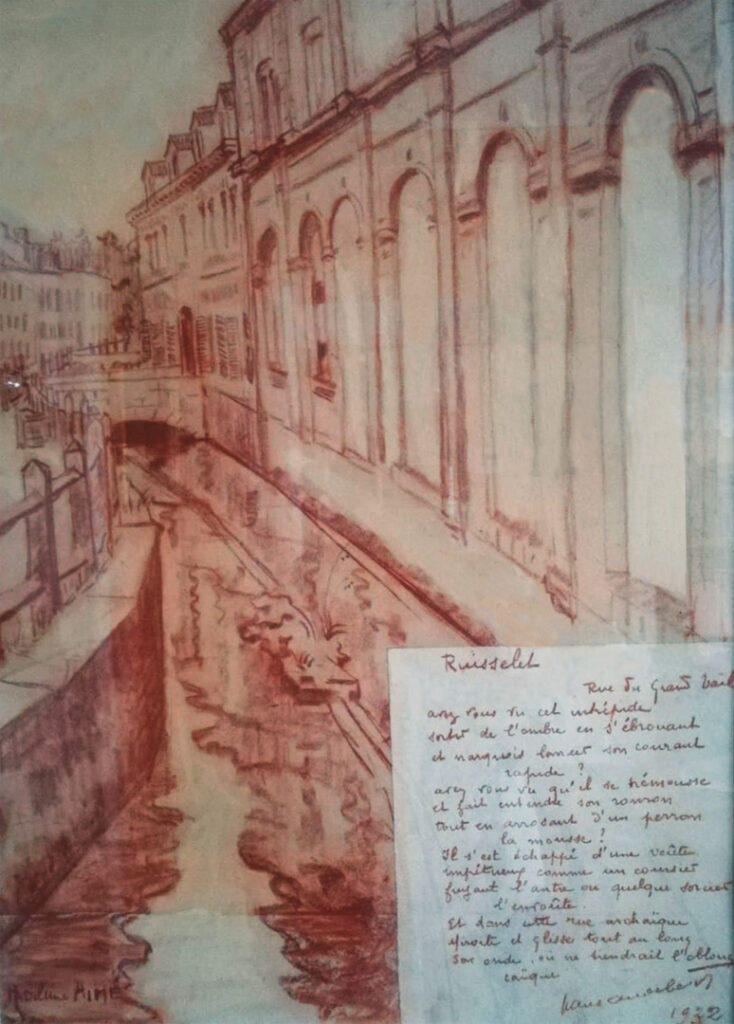
Rue du Grand Bail à Douai
Private collection – ©FamilleAime
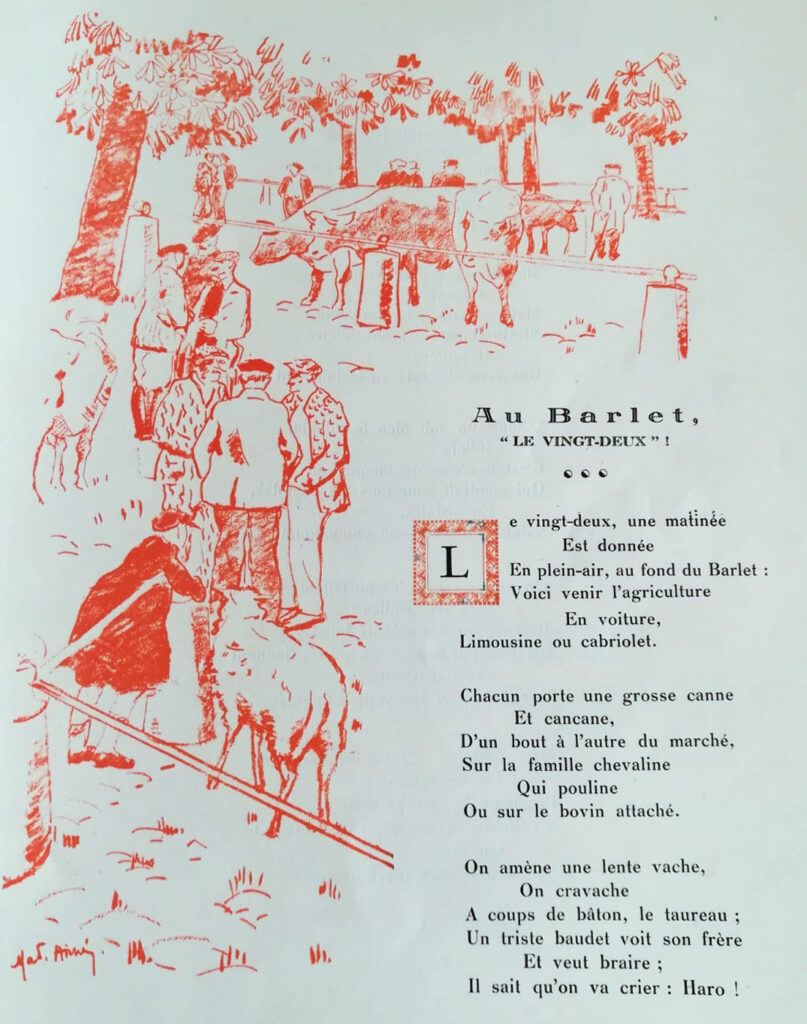
Editions Dutilleux – ©FamilleAime
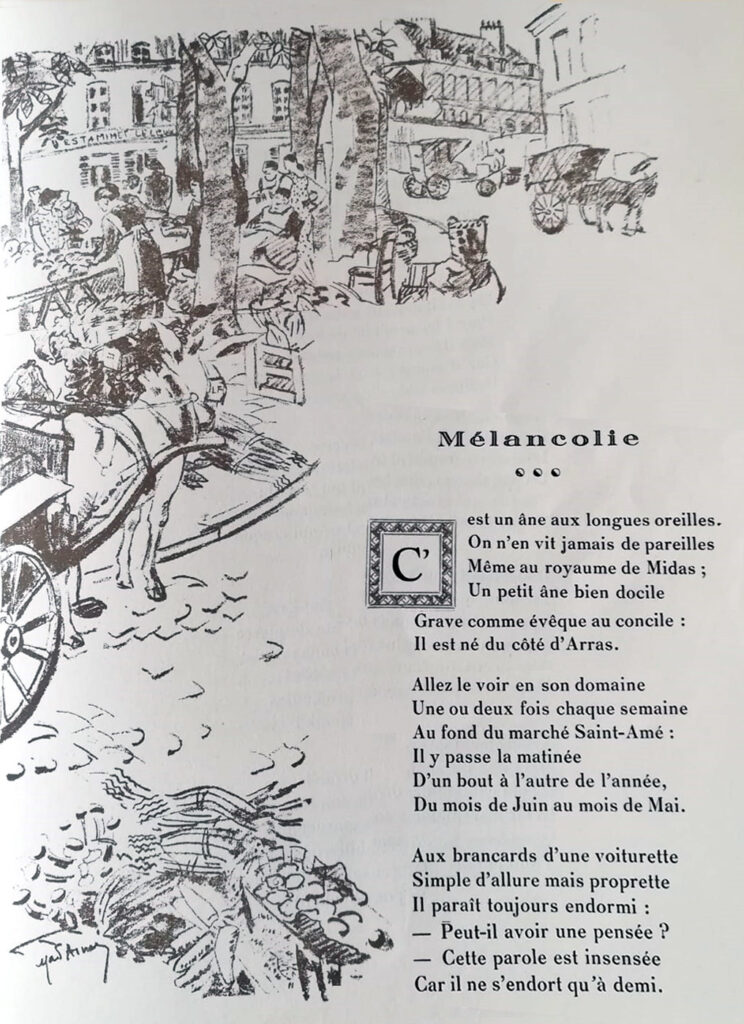
Editions Dutilleux – ©FamilleAime
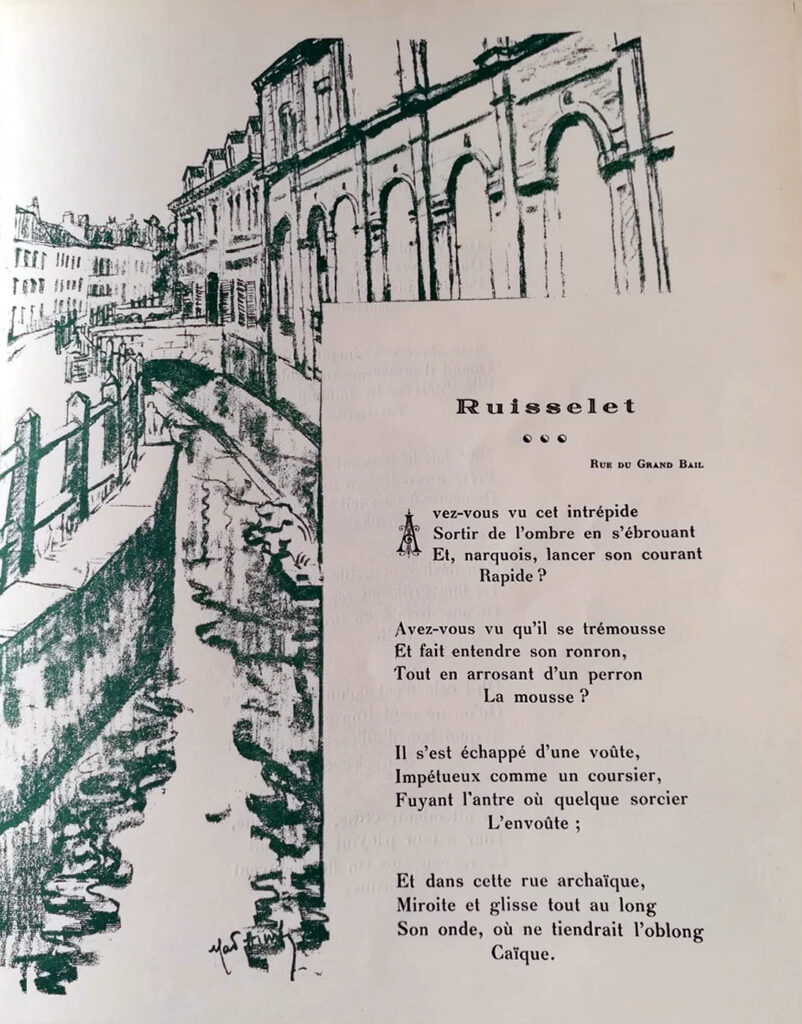
Editions Dutilleux – ©FamilleAime
Training of Madeleine Aimé


©FamilleAime
Madeleine Aimé began her artistic training at the Ecole des Beaux-Arts de Douai.
In October 1927, she entered the Ecole Nationale des Beaux-Arts de Paris in the workshop of Ferdinand Humbert (1842 – 1934) (registration number 980).
It is important to know that at that time the painting workshops were not mixed.
Her teachers will be :
René-Xavier Prinet (1861 – 1946)
Head of the painting workshop for women students from 1929 to 1932.
Fernand Sabatté ( 1874 -1940 )
Head of the painting workshop from 1932 to 1940.
It was during his professorship that the painting workshop became mixed.
Madeleine is a brilliant student with a passion for drawing. She won the Conté prize at the Beaux-arts de Paris.
A renowned artist
- 1932
> Illustration of 3 poems from the collection Au pays de Gayant by Paul Audebert (see above)
> The Musée de la Chartreuse in Douai acquires two sanguine drawings made by Madeleine. These two drawings were unfortunately burned in the fire of the museum caused by the bombing of the city of Douai on August 11, 1944.
> Madeleine was recruited by the CNRS to work with the paleobotanist Paul Bertrand at the Lille Faculty of Science.
> She also began to exhibit in the Parisian salons. First at the Salon des Artistes Français of which she quickly became a member and then an honorary member from 1942. She regularly exhibited at the Salon d’Hiver, the Salon des Femmes Peintres and in various Parisian galleries. - 1938 – Madeleine moved to her studio at 11 rue Daguerre in Paris and joined the Muséum National d’Histoire Naturelle (mnhn) in Paris.
- 1942 – She realizes the 14 stations of the Way of the Cross in the church of Saint Theresa of Douai. This modern church, which is located on rue de Cuincy, was built between 1939 and 1941 by the diocese of Cambrai.
Honorable Mention at the Salon des Artistes Français - 1943 – At the Salon d’Automne she exhibited 3 paintings
N°5 – Le Scout
N°6 – Paysage
N°7 – Paysage
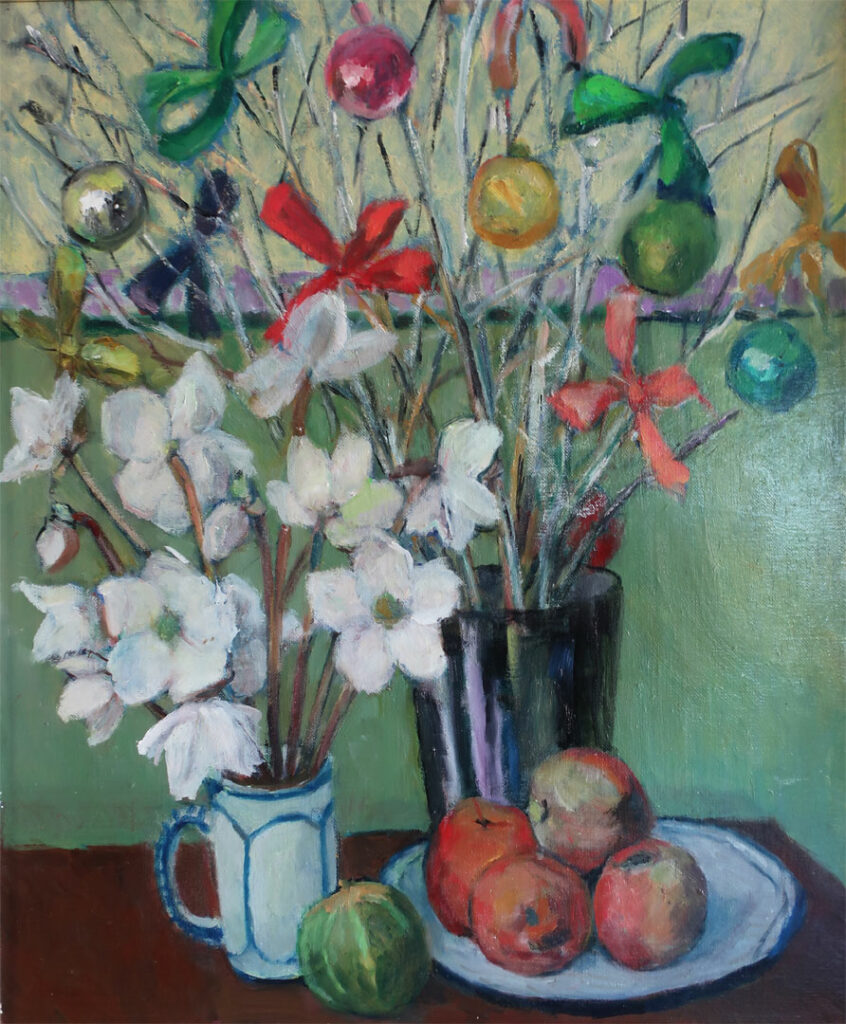
Private collection – ©FamilleAime
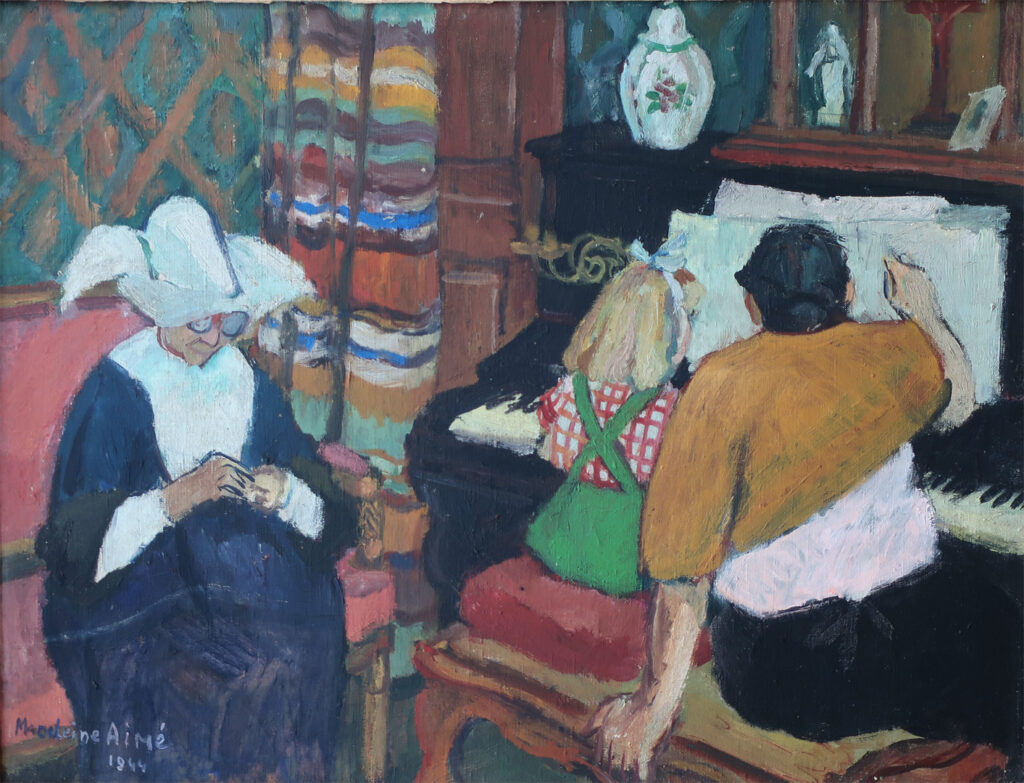
Private collection – ©FamilleAime
- 1944 – She was awarded the Palais de Longchamp prize at the Salon des Artistes Français
- 1948 -At the Salon (61st official exhibition of Fine Arts)
She exhibited in the painting and drawing section:
N°7 – Portrait of Yvette (painting)
N°8 – A bridge in Paris (painting) - 1950 – At the Winter Salon (41st) from October 21 to November 26,
She exhibited at the same time as R.H.L., Liao and André Brageu
N° 251 – The guitar (Painting)
Madeleine was at the height of her career as a painter. She was now a renowned artist whose works were exhibited in numerous salons.
Faithful all her life to her studio at 11 rue Daguerre in the XIVth arrondissement of Paris, Madeleine was very involved in the promotion of Art in this arrondissement. She contributed to animate the Association of Painters and Sculptors of the XIVth, (APST-14) and she regularly exhibited at the Salon de la Mairie du XIVe arrondissement de Paris.
And of course, until the end of her career she exhibited in her hometown at the Salon des Artistes Douaisiens and in Aniche, a town located about twenty kilometers from Douai.
In the dictionary of Bénézit painters, Madeleine is recognized for her still lifes (bouquets of flowers in particular), her paintings of Douai and the surrounding area.
An illustrator at the service of science

In addition to her career as a painter, Madeleine was recruited in 1932 by the CNRS who seconded her to the paleobotanist Paul Bertrand (1879-1944).
At that time, Paul Bertrand was working at the Faculty of Sciences of Lille where he was in charge of a chair of paleobotany.
Paleobotany makes it possible to retrace, thanks to the study of fossil plants, the great stages of the evolution of plants. It is thus possible to reconstruct ancient landscapes.
In close collaboration with the paleobotanist, Madeleine puts all her mastery of drawing and her artistic sensitivity at the service of the scientist’s observations in order to reconstitute the Carboniferous forests (300 million years ago).
In 1937, for the International Exhibition in Paris, Paul Bertrand presented his work on the evolution of plants in a room at the Palais de la Découverte. Visitors could admire Madeleine’s drawings.
In 1938, Paul Bertrand left Lille to join the National Museum of Natural History in Paris (chair of comparative anatomy of fossil plants) and Madeleine followed him. She worked there until 1964/1965.
Collaborating with other researchers, she made a series of drawings of fossil forest landscapes and drawings of dinosaurs.
Madeleine Aimé excelled in her work as a scientific illustrator and one can only admire the refinement of her drawings.
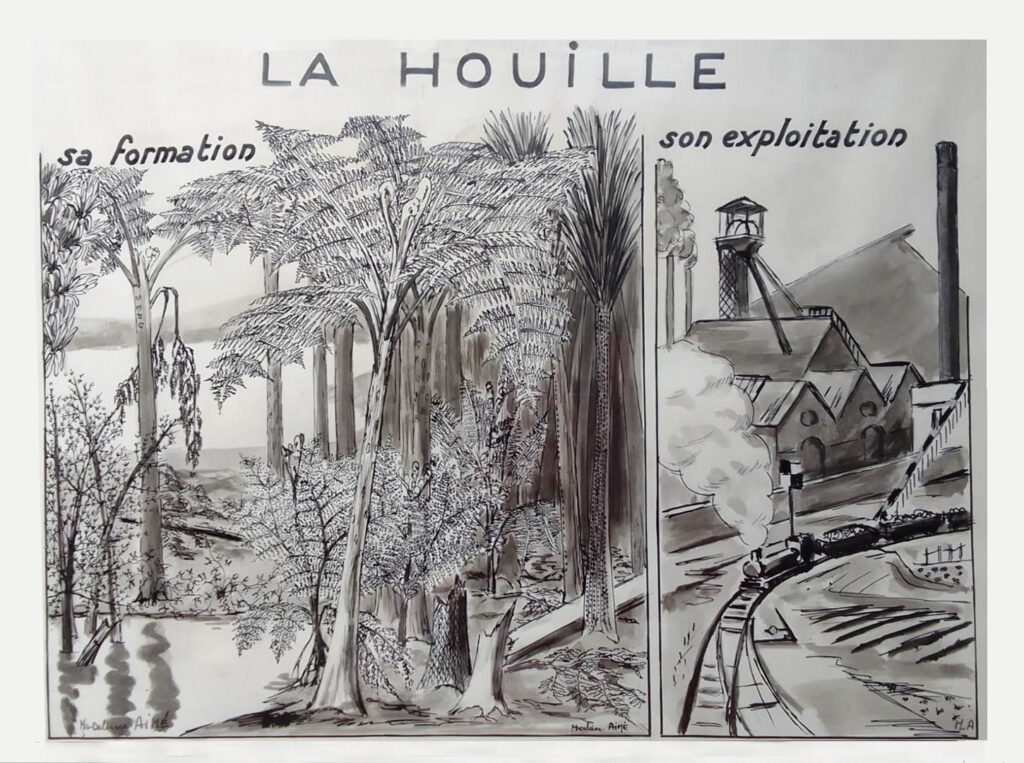
Private collection – ©FamilleAime
One of Paul Bertrand‘s favorite research topics during his time in Lille at the Faculty of Science was the study of Carboniferous plants at the origin of coal seams in the coalfields of northern France.
He used drawings by Madeleine to illustrate his research.
In his book Annales de Paléontologie – Reconstitutions de Paysages Fossiles, published in 1950, Paul Bertrand pays tribute several times to Madeleine’s talent.
The following caption, written by Paul Bertrand, can be read in this work:
« This watercolor, due to the talent of Miss Aimé of the Muséum National d’Histoire Naturelle (Paris) represents, in a synthetic way, the main botanical types characteristic of the Carboniferous of our European regions. Atmosphere of heavy humidity, perhaps rich in carbon dioxide, favorable to the development of large plants with large and thick leaves.
In the shade of these dense forests, proliferated numerous species of smaller dimensions, with delicate blades. One can only get a close idea of the luxuriance of this vegetation of the Carboniferous period, by observing the current state of certain tropical regions, particularly humid. »
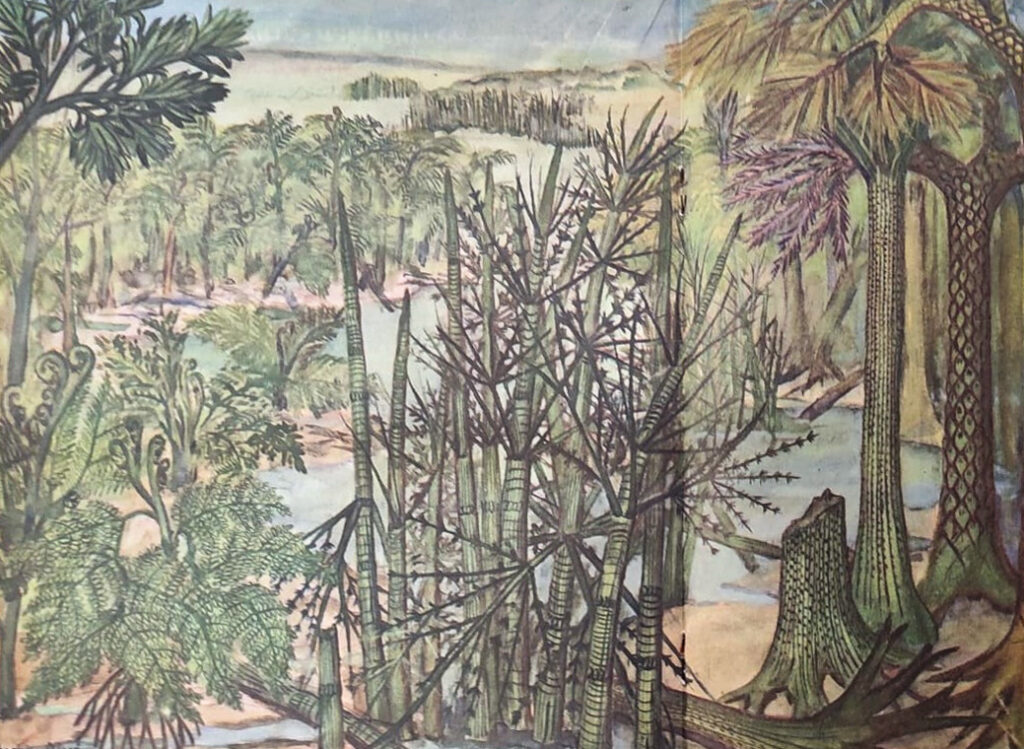
in the book by Paul Bertrand published in 1950
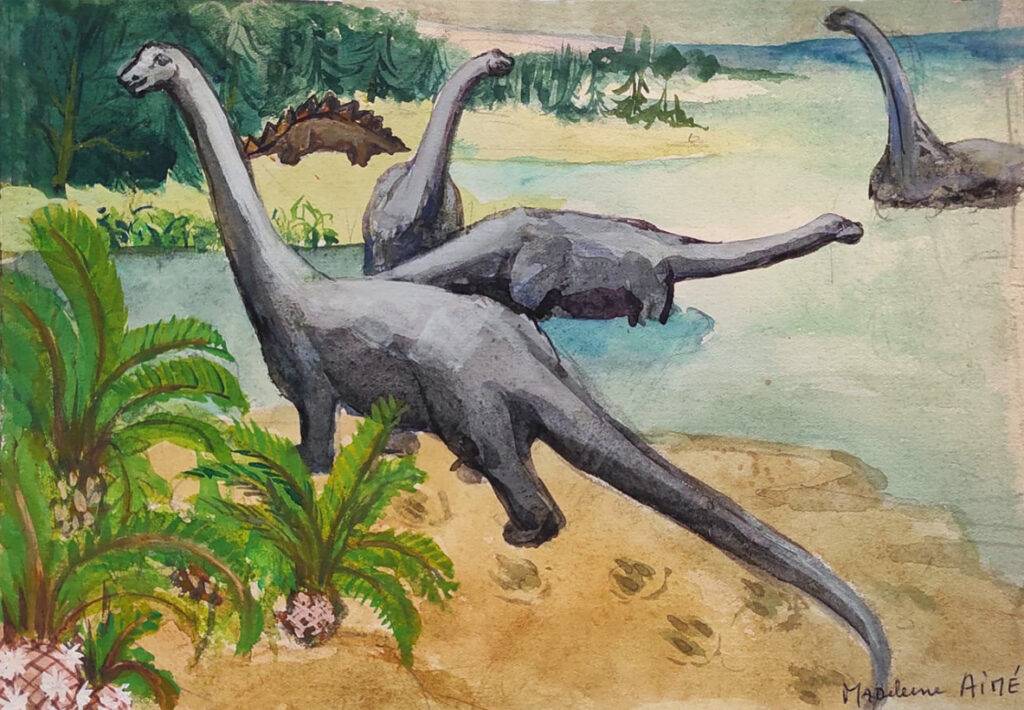
Private collection – ©FamilleAime
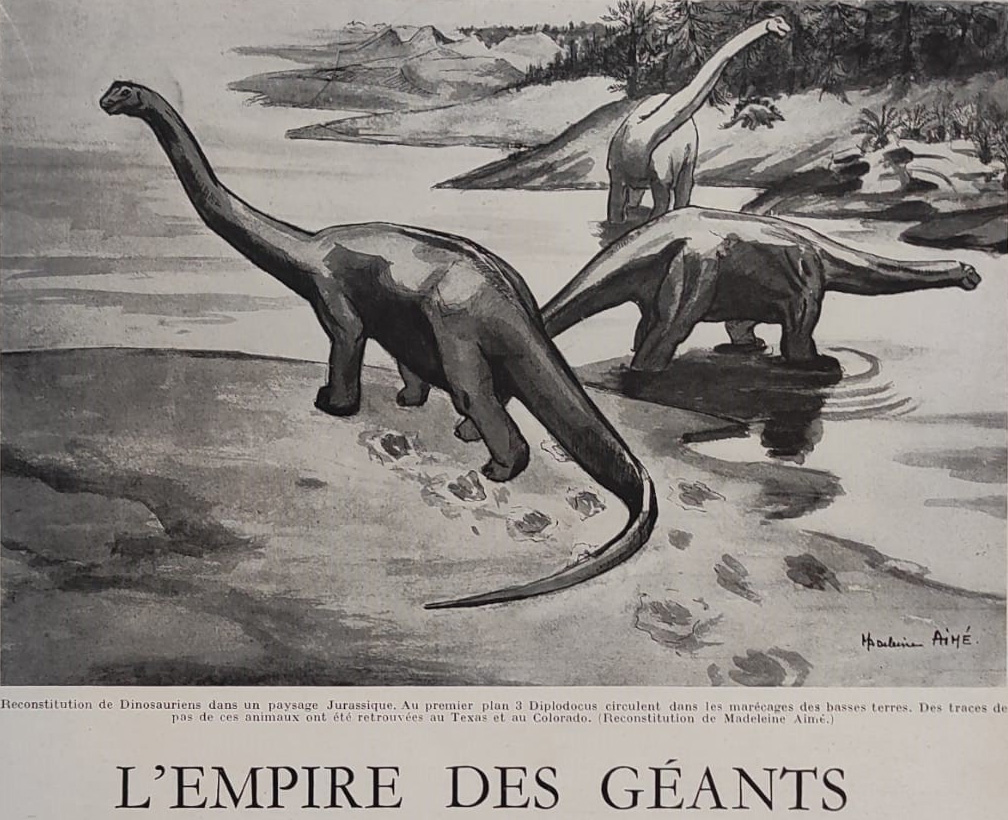
illustrating the work of the scientist René Lavocat on the dinosaurians

Private collection – ©FamilleAime
Madeleine and Rolande
An unfailing friendship
Madeleine Aimé moved into her studio on rue Daguerre in 1938 and it was through her that Rolande Hubert Leveugle moved in as well in 1942.
Madeleine and Rolande already knew each other because of the friendship that had always linked the Aimé and Leveugle families, both of whom lived in Douai.
Twenty years separate Madeleine and Rolande and when Rolande “lands” in Paris at the age of 18, in the middle of the world war, she finds comfort and support from Madeleine.
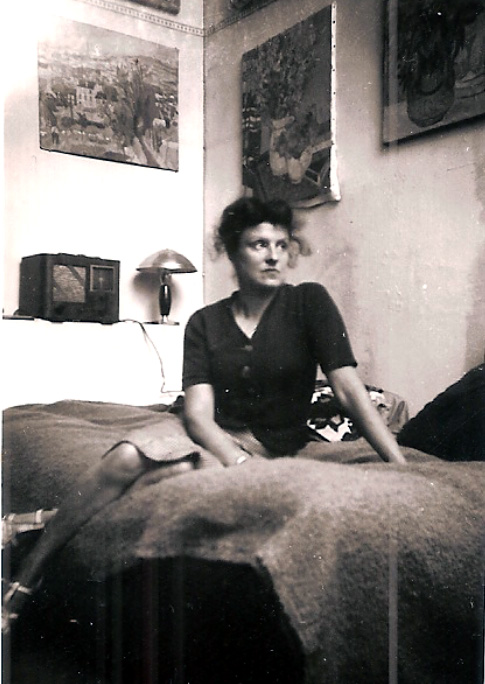
©FamilleAime
he mutual affection that was born during these difficult years will never fade.
It is true that it is necessary to tighten the elbows.
The families Leveugle, Aimé and also Brageu are struggling to send letters and parcels to the artists of the rue Daguerre:
A suitcase full of coal, a kg of sugar, flour, noodles, a packet of “casse-croûte” cake, a toothbrush, a box of potatoes… everything is good to take, supplies are so problematic in Paris during this period.
And above all, people exchange news, worry about their loved ones, and there is plenty to do.
.
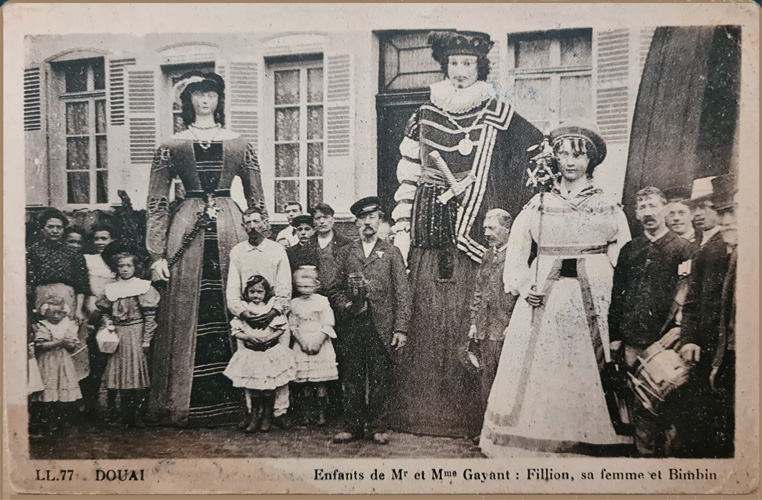
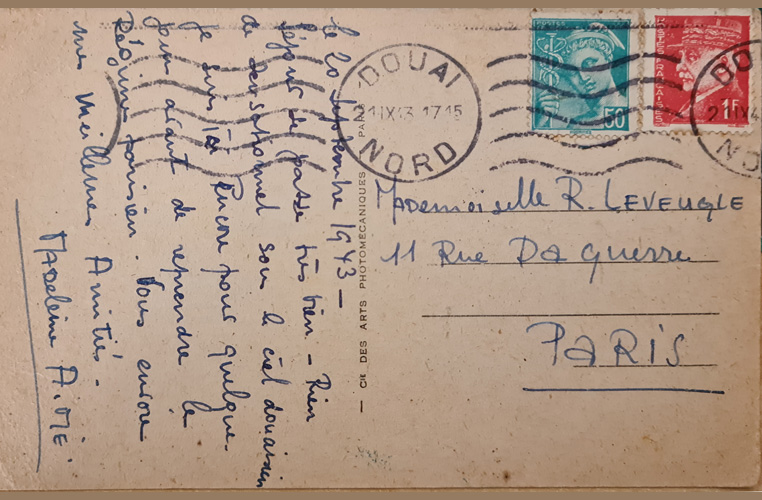
After Rolande’s marriage to the musician André Hubert in 1944, Madeleine remained close to the couple. They shared good times such as camping vacations in Saint-Briac with Liao Xinxue, joyful outings with artist friends, in the forest of Fontainebleau, not to mention the birthday parties always celebrated with dignity.
André doesn’t hesitate to knock on Madeleine’s door to beg for a good meal when he finds himself alone in Paris and gets tired of his regular restaurant “le Petit Monge”.
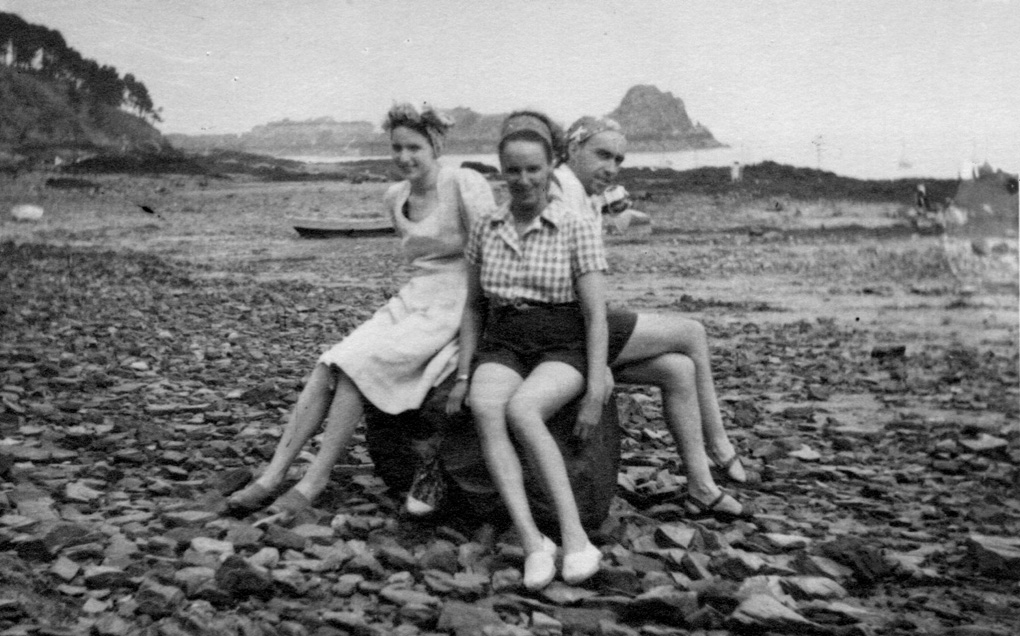
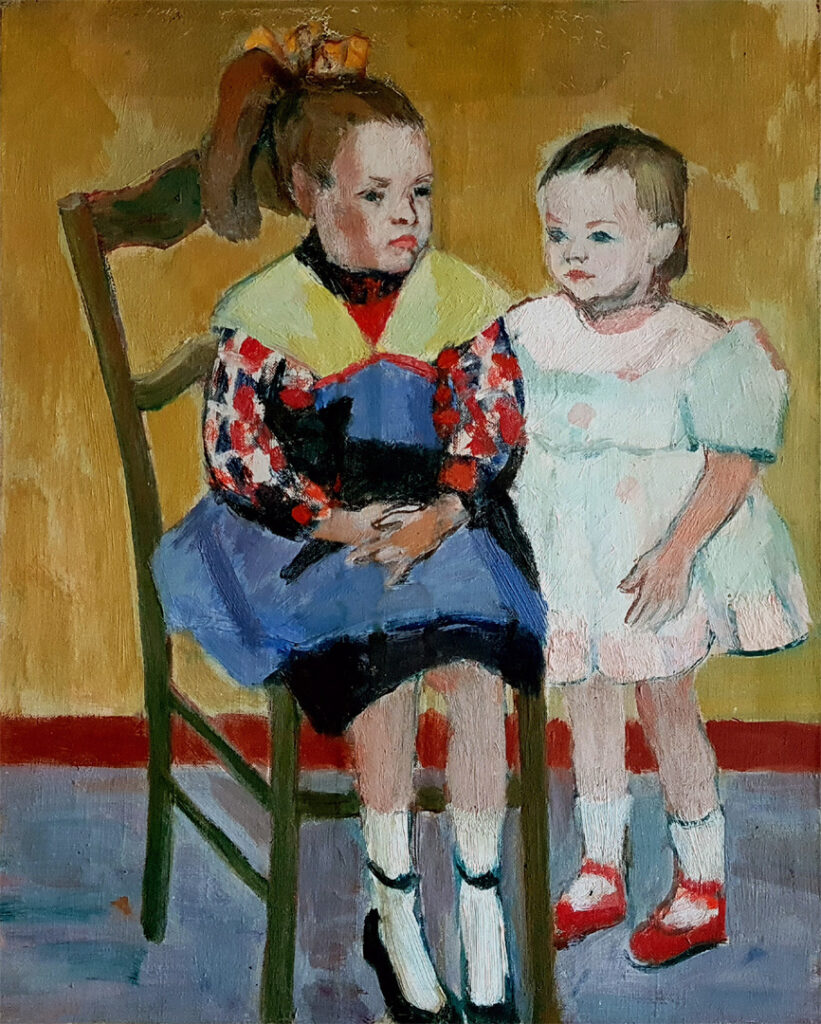
Private collection – ©R.H.L.
The friendship of Madeleine and Rolande, will survive Rolande’s departure from the capital in 1960. Not a year goes by without them exchanging news. They share their happy or tragic events, like the death of Taï Tou, Madeleine’s great friend.
When they meet, it is as if they had never left each other.
Sometimes Madeleine stops in Rennes on her way to Saint-Quay-Portrieux where she regularly spends her vacations. Conversely, Rolande stops in Paris for a “lightning stay” on the occasion of a trip. It is always with the same pleasure that they meet again.
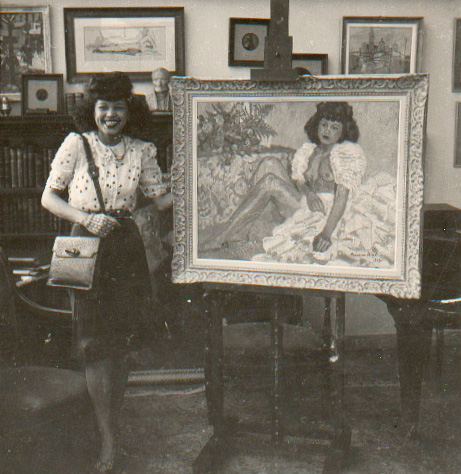
©FamilleAime
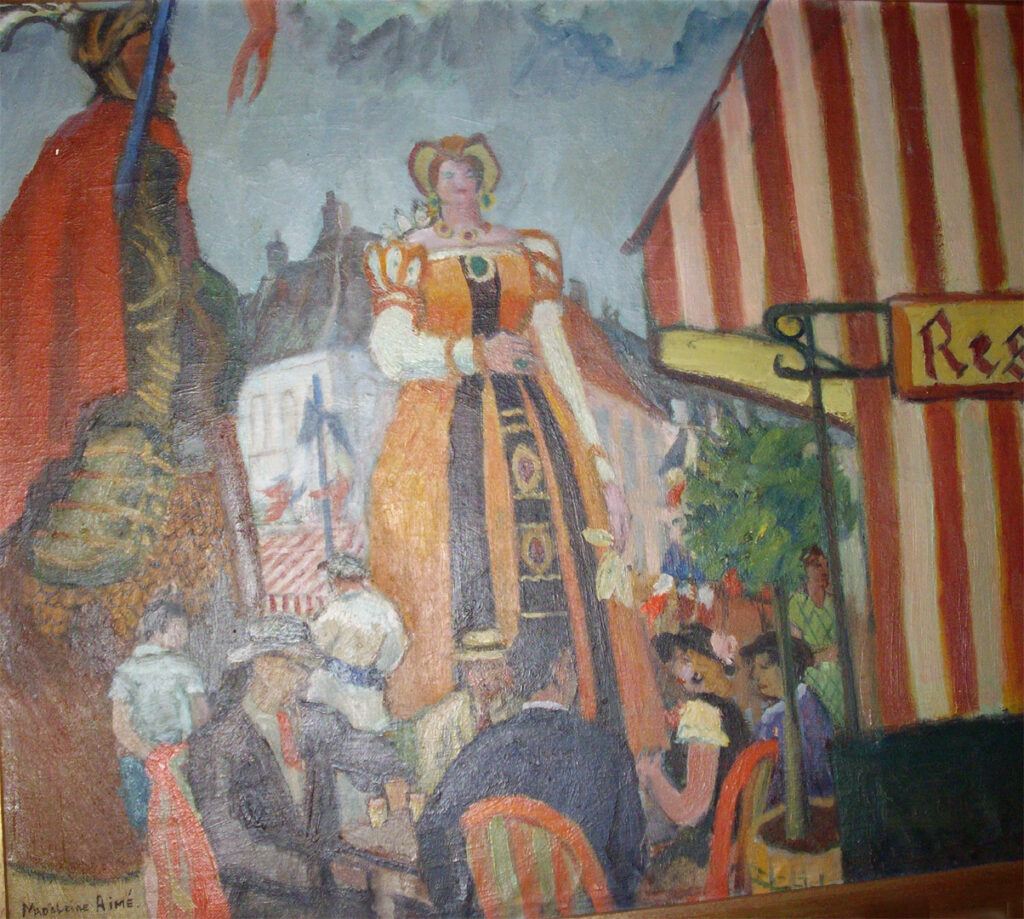
Private collection – ©FamilleAime
Madeleine likes to travel abroad, often with her brother Charles (Spain, Yugoslavia, Turkey, Morocco, Tunisia…) and she always has a little thought for Rolande.
She remains very attached to her city of Douai and goes there whenever she can to see her family.
In 1985, on her return from Douai, she wrote to Rolande:
“These days, I paint, according to notes, sketches made in Douai, on the days of the Gayant festival: I am doing 2 paintings, I would like you to see them to give me your opinion… I hope to see you again and will come to say hello and see what you are doing…”.
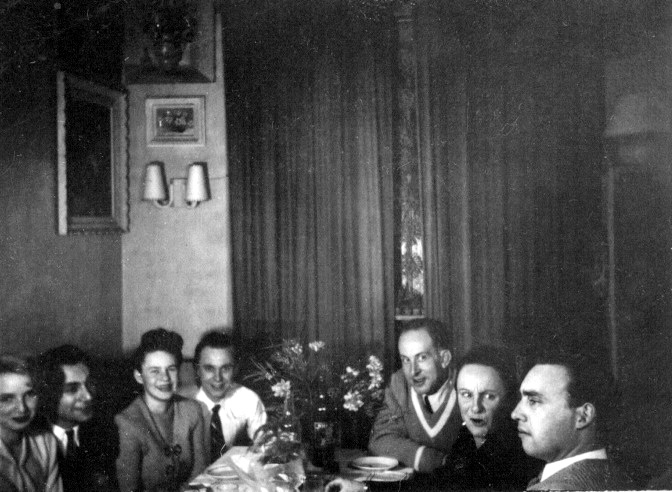
From left to right: Rolande Hubert leveugle (painter), Jean Legrand (photographer), Yvette Filiti, André Brageu (painter), Louis-Paul Robin (painter) called “Loulou”, Madeleine Aimé (painter) and André Hubert (musician at that time).
The last reunions
In 1991 and 1992, Madeleine and Rolande participated in two exhibitions organized by their painter friend, Georges Hugot, in Aniche.
Georges invited several generations of former students of the Beaux-Arts of Douai. About fifty of them answered his call and they met in an atmosphere of great complicity and emotion.
Some artists have not seen each other since their studies and it is with a touch of nostalgia that they evoke their memories of their years of study at 22 rue des Foulons then rue de Wetz in Douai.
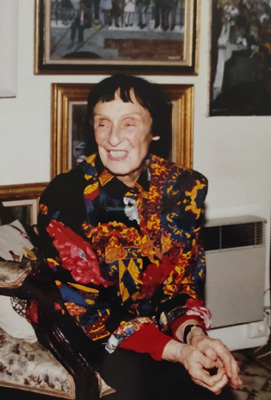
In 1991 Madeleine exhibited :
It’s Gayant (oil)
The students (drawing)
In 1992 Madeleine exhibited
The Christmas tree
The model
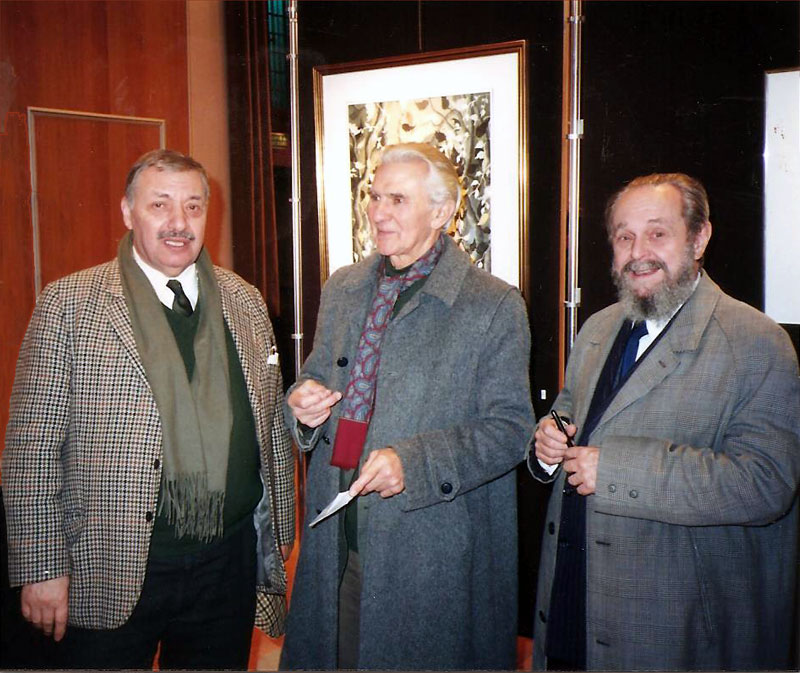
Madeleine Aimé died in 1996. She only left her beloved XIVth district under duress a few months before her death in Châtillon.
Tribute to Madeleine Aimé at the Natural History Museum of Lille

The Musée d’histoire naturelle de Lille has organized, from May 14 to October 2, 2022, an exhibition dedicated to the work of Madeleine, artist and scientific illustrator.
“Madeleine Aimé, artist of the fossil forests“
One could admire the original drawings of the artist, preserved by the museum, as well as many plant fossils of the mining basin.
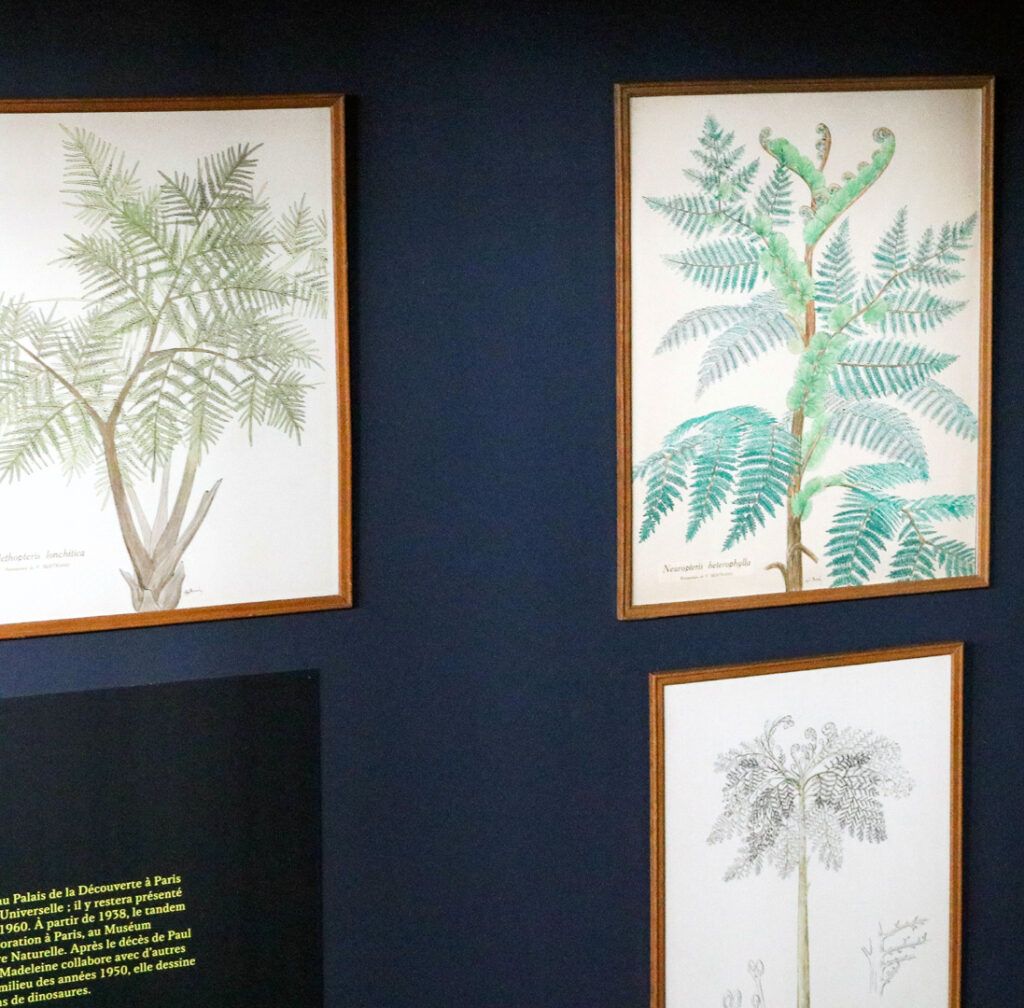
Gallery – Still life
Private collection of the Aimé family
Gallery – Scenes of life – Portraits
Private collection of the Aimé family
Anecdotes
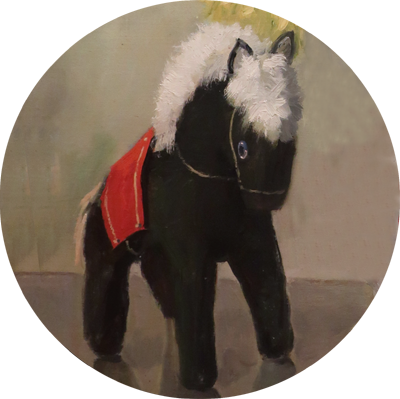
Who am I ?
I appear on several paintings by Maurice and Madeleine Aimé.
I am a little stuffed animal that belonged to one of Madeleine’s nephews.
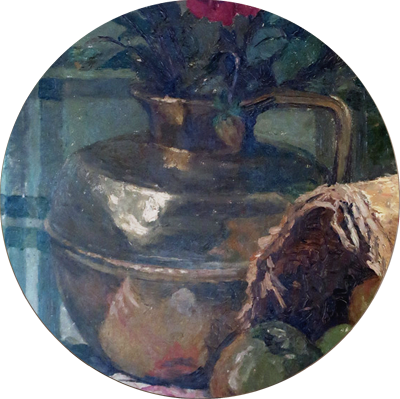
La canne à lait
It is the ancestor of the aluminum milk can. It was used until the interwar period to transport and store milk. The canne à lait, typical of Normandy, had a concave bottom to be carried on the shoulder. Each region of France had its own model.
References
Documents
Catalogues des Salons de la Société des Artistes Français – Gallica.bnf.fr – Bibliothèque Nationale de France
Catalogues du Salon d’hiver – Gallica.bnf.fr – Bibliothèque Nationale de France
Recueil de poèmes illustrés : Au Pays de Gayant par Paul Audebert – Editions Paul Dutilleux
Histoire de la faculté des sciences de Lille – https://asap.univ-lille.fr/ASAP/publications/Tome8_geologie.pdf
Musée d’histoire naturelle de Lille
Iconography
Musée de la Chartreuse de Douai : « Les Peintres douaisiens – 1930 » Emma Sirot N° inv. : 2021.11 ©Douai,
Gallica.bnf.fr – Bibliothèque Nationale de France
Postcard Gayant children : LL.77 – 1943 ©Douai
Guide pratique du S.I. de Douai ( la Cité des Géants) – Edition de 1953 – n° 10 ©Douai – Photo – A. Faidherbe
Private collection R.H.L. ©R.H.L.
Private collections of the Aimé family ©FamilleAime
